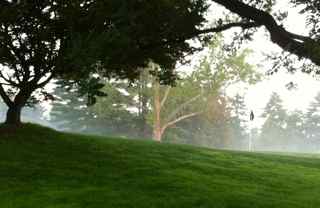^zhurnaly 0.9905

Howdy, pilgrim! No ads — you're in volume 0.9905 of the ^zhurnal (that's Russian for "journal") — see ZhurnalyWiki for a Wiki edition of individual items; see Zhurnal and Zhurnaly for quick clues as to what this is all about; see Random for a random page. Briefly, this is the diary of ^z = Mark Zimmermann ... previous volume = 0.9904 ... complete list at bottom of page ... send comments & suggestions to "z (at) his (dot) com" ... click on a title link to go to that item in the ZhurnalyWiki where you can edit or comment on it ...
RSS
~17 miles @ ~11.2 min/mi
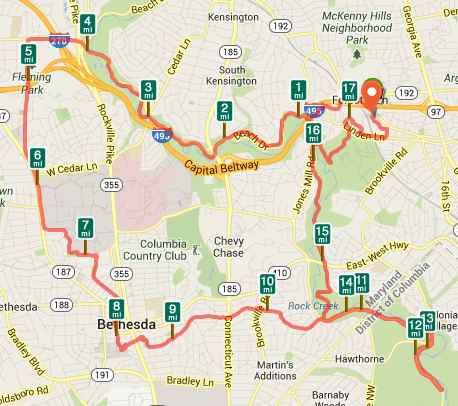 | Starting at 5:41am to make a 7am rendezvous in downtown Bethesda, I decide to attempt to take Rock Creek upstream to the Bethesda Trolley Trail. That works out well — I arrive within a minute of the planned time to find Sandra "Sam" Yerkes waiting by the Barnes & Noble bookstore fountain, Ken Swab just arriving, and shortly behind him Rebecca Rosenberg and Gayatri Datta. But that smooth arrival hides some frantic sprinting and a couple of sub-9 minute miles along the BTT. A fireman returns my wave as he guiltily takes a smoke just outside the NIH security fence. An SUV almost bumps me when the driver apparently thinks about running a stop sign, but fortunately doesn't. One big deer eyes me near Connecticut Av, and a pair of rabbits flees into front yard bushes on Leland St. I hang with Gayatri Datta and learn about her Yellowstone Park and Bighorn Marathon experiences — all good — as the others trot ahead and do some extra mileage down Beach Dr. Returning to Leland I turn Gayatri over to Sam and dash some more fast final miles homeward, with a pause to photograph the ever-lovely Mermaid Fountain at National Park Seminary on the way. RunKeeper awards a bonus ~0.2 miles, mainly from the Wisconsin Av tunnel GPS glitch, compared to the Garmin wrist unit. |
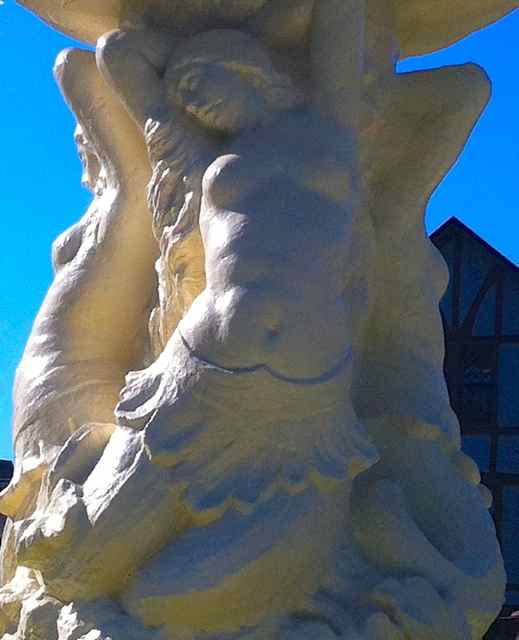 | Garmin splits: 10:28 + 10:19 + 10:50 + 9:42 + 10:46 + 9:34 + 8:47 + 8:32 + 14:56 + 13:23 + 13:10 + 12:37 + 15:29 + 12:44 + 9:24 + 8:46 + 12:22 and a final fraction at 8:50 min/mi pace | 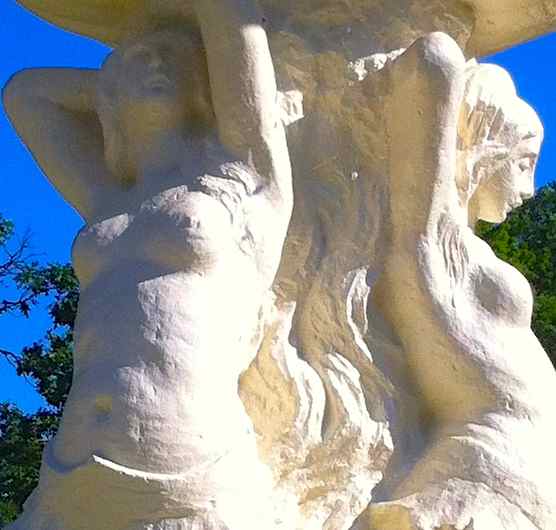 |
- Wednesday, July 17, 2013 at 04:17:15 (EDT)
A cheerful thought from dear friend Rayna Matsuno Weise:
| "This isn't the end of Everything — just the end of Now and the start of Right After Now." |
Rayna was inspired perhaps to some degree by the essay "Day 28" of Meditations from the Mat, a gentle book by Rolf Gates and Katrina Kenison that another dear friend, Kate Abbott, recommended not long ago. See also John Darnielle's song Woke Up New, which ends, "... And I got ready for the future to arrive."
- Tuesday, July 16, 2013 at 04:19:11 (EDT)
The film Magicians (written and directed by James Merendino) is an offbeat comedy, staggering and stumbling ultimately to a perhaps-unsatisfying conclusion. But along the way, there are thoughtful moments as well as laughs. Most memorable are the words of Alan Arkin's character Milo about the ultimate mission of magicians:
| "We are like doctors — Imagination Doctors!" |
... and everybody's imagination needs a bit of physic sometimes.
- Monday, July 15, 2013 at 04:10:09 (EDT)
~2.9 miles @ ~15 min/mi
Rabbits at sunrise: Kristin Heckman and I walk/run lapin-laps around the MITRE parking lot; she starts early and does ~3/4 mile extra. Kristin has The Eye and points out multiple creatures that I would have overlooked. Runkeeper records the route. Conversation as always is therapeutic, as we compare notes and thoughts on life, literature, family, work, health, and mindfulness.
- Sunday, July 14, 2013 at 05:41:32 (EDT)
~12 miles @ ~10.5 min/mi
Light drizzle turns to outright rain as Ken Swab and Rebecca Rosenberg join me for middle miles on the CCT. Only one Warren St rabbit is out today. The actual distance is ~12 miles, since the iPhone Runkeeper GPS has mega-glitches both times emerging from Wisconsin Av tunnel, as compared to the Garmin. Vee Hartenstine sprints by and greets me at mile 10 on the way home. Garmin splits: 10:11+ 9:20 + 9:27 + 10:51 + 12:39 + 10:42 + 11:18 + 11:45 + 10:11 + 8:56 + 10:44 + 9:36 min/mi.
- Sunday, July 14, 2013 at 05:39:12 (EDT)
At the end of Chapter 4 ("Being No-Self and Being Nice") philosopher Owen Flanagan in The Bodhisattva's Brain suggests a philosophy of life for someone who doesn't believe in a "self" (atman):
The analytic philosopher and scientific naturalist who denies that we humans are or have atman has his own way to defend anatman, either in an Aristotelian or neo-Lockean way or possibly both at once, depending on how close or far away he understands the views. One could imagine, although there is no necessity, a Western philosopher from our no-self tradition(s) advising that seeing oneself as a selfless person gives one some reason to beware egoism and to live compassionately. It is rational for each of us to proceed to find the best niche for oneself, for a person with one's talents and interests. Find some worthy goals and projects that suit you, and get fired up and passionate about them. Sure, work those projects from the here and now. Don't get ahead of yourself. Delight in the small steps along the way. And don't let the setbacks surprise or defeat you. But always remember, never forget, never lose sight of the fact that once you figure out what sort of worthy projects suit you, nothing less than the meaning of your life turns on doing your best to make them work out. Well, that and being as lovingkind and compassionate and unselfish as possible. Your job is to make sure you choose projects that do not diminish the prospects that when you die the story is one of a wise person who led, as far as possible, an excellent life. If you dedicate yourself to living wisely and compassionately and mindfully, then even if you, for some reason, miss out on knowing when and how the final chapter ends, we will rightly say that you led a good human life and flourished. If there were gods, they'd bless you. But there aren't, so they won't. But we, your fellows who remain alive and on our own personal journeys, will be grateful for who you were and how you were. You flourished, Buddhist style, and you increased our chances for doing the same.
How sweet!
(cf. My Religion, ...)
- Saturday, July 13, 2013 at 04:31:55 (EDT)
~15 miles @ ~10.5 min/mi
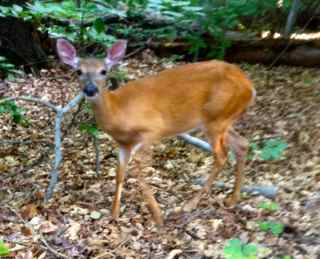 | At dawn as I run down Warren St toward the Capital Crescent Trail a bunny scampers off the sidewalk in front of me. Half a block later another does likewise. Could this street be named not for a person, but for a long-ago nest of critters? One more rabbit flees my approach five miles later, along River Rd. There are also countless cardinals and robins and squirrels, one chipmunk, and a fearless-foolish young deer that poses for me at mile 14+ on the climb up Ireland Dr from Rock Creek on the final homeward stretch. |
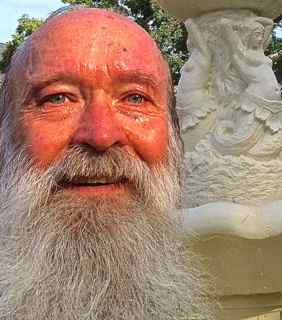 | Initial pace plan is 11-12 min/mi and even though it's rather humid I manage to improve on that via a succession of sub-10 miles in the middle. Blood stains from abraded nipples do a chromatography experiment on my white shirt, but pain is minimal until during the post-run shower when sweat washes down. Few other runners are out until I reach Rock Creek Park, where I meet multiple MCRRC training groups that include folks who greet me by name; Bob Yarchoan and Anny Rosenthal are among the few whom I know, alas. At Candy Cane City shortly after 7:30am Barry Smith, Emaad Burki, and Alyssa Smith (whose name I am embarrassed to ask) are awaiting others to materialize for their trek. Barry begins to tell the Woodchipper Story from last week's Bighorn ultramarathon but I apologize and ask him to recount it for me later, since I have to rush home to go to the Silver Spring farmers market and the Bank on behalf of DD & DW. Under Rock Creek Trestle I almost bump into long-time friend Norm, and promise him a better explanation of Bayes Theorem at a later date. |
Runkeeper glitches at the Wisconsin Av tunnel and awards me a bonus ~0.2 mile compared to the Garmin. Its splits are 10:36 + 10:17 + 11:55 (photo op at Columbia Country Club) + 11:08 + 9:53 + 9:34 + 9:54 + 10:17 + 9:02 + 11:23 (water bottle refill) + 10:04 + 9:54 + 10:19 (greet friends at Candy Cane City) + 9:05 + 13:38 (multiple photos) and a final fraction at 12:02 min/mi pace. The scale reads 144.2 lbs before, 141.1 immediately after, and 142.2 a couple of hours later post-recovery meal.
- Friday, July 12, 2013 at 04:12:48 (EDT)
From the final paragraph of The Tarantula, a delightful little book by William J. Baerg, published in 1958 and given to me recently by brother-in-law Michael Lawrence Dickerson:
| When Professor Comstock of Cornell University, an eminent entomologist and a recognized authority on spiders, was asked by a visitor, "What good are spiders?" he seemed at first somewhat baffled; then he explosively replied: "What good are they? They are damned interesting." |
- Thursday, July 11, 2013 at 11:39:12 (EDT)
~10.7 miles @ ~11 min/mi
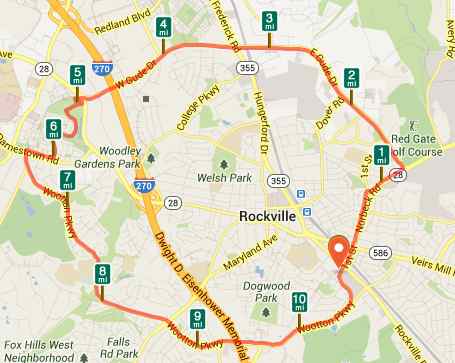 | Father's Day is the day for Father to do the family chores, right? After grocery shopping and mowing the lawn of the New Place it's time to head out to Rockville and deliver the 2013-04-13 - Bull Run Run 2013 "Team Rocket" biggest loser awards, monogrammed blankets, to teammates Jennifer Wieland and Mike Edwards. Jennifer is digging a trench in the back yard of her new place with a roto-tiller, back from South Dakota with a new puppy. I leave Mike's blankie with her. Since she has no other local trail suggestions I revisit the Carl Henn Millennium Trail that circles the town. Parking at mile marker 5 gets me started counter-clockwise. At 2pm the temperature is in the mid-80°F zone, and humidity is high. Intermittent breezes, and showers so light that I barely know they're there, help — but not enough. Splits tell the sad tale: 9:40 + 10:27 + 9:59 + 11:25 + 11:01 + 12:45 (water stop at rec center) + 10:56 + 10:33 + 11:22 + 11:23 + 10:35 (final fraction min/mi). The first few miles are optimistically too fast, and then reality and walk breaks set in. Garmin and Runkeeper agree to within 2%. One water bottle isn't nearly enough. A blitz (relatively speaking) for the last half mile keeps the total average pace safely under 11 min/mi. Few others are foolish enough to be out today, but the heat acclimation should help in the long term. At Taco Bell afterwards a couple of glasses of Diet Pepsi and another cup of unsweetened tea fail to fully restore hydration. |
(cf. 2011-08-17 - Rockville Millennium Trail, 2011-12-26 - Rockville Millennium Trail Loop, ...)
- Wednesday, July 10, 2013 at 04:14:17 (EDT)
Stephen Batchelor in Living with the Devil, Chapter 14 ("This Body Is Breathing") muses upon the human animal and describes ways to remain immersed in the actuality of life. He suggests:
... Having found a stable posture in which the back is upright, bring the totality of attention to the physical sensation of the breath as it enters the nostrils, fills the lungs, pauses, contracts the lungs, is exhaled, pauses, and so on. Do not control the breath; just rest with calm curiosity in an awareness of the body breathing. If the breath is short and shallow, then notice it to be short and shallow. If it is long and deep, notice it to be long and deep. There is no right or wrong way to breathe.
... The trick is to learn how to remain fully aware of the breath without that awareness impeding its natural ebb and flow.
One way to do this is to wait for the breath to happen. After each inhalation and exhalation, there follows a brief pause as the muscles change gear, as it were, before releasing the pent-up air or drawing a fresh breath. The self-consciousness of breathing is most pronounced at these two moments: suddenly it feels as though "I" must exhale or inhale. To dispel this sense of agency, during each pause remain a disinterested observer, curious to notice when and how the muscles will engage of their own accord to initiate the next inbreath or outbreath. Just wait for the next phase in the breathing to kick in: with no expectation as to when it should start, no preparation for it to be deep or shallow, no anticipation for it to be forceful or gentle.
Batchelor goes on to suggest using the breath as "... the anchor to which one returns each time the mind is snatched away by daydreams or memories ..." and "as a barometer of one's mood." He proposes that:
... The stillness of mindfulness is not one of trancelike absorption, where attention remains locked on a single object, but an expansive restfulness in which a radiant and supple clarity attends to whatever appears.
And whatever appears, disappears. The closer one attends to the unfolding of life, from thoughts that flit through one's brain to the serene blue canopy of a cloudless sky, the more the inconstancy of things becomes apparent. ...
He concludes, "As one settles into a contemplative acceptance of the selfless flux of experience, one discovers that, just like the breath, it too happens of its own accord. Even the observing awareness is a momentary consequence of sense data impacting the organs of a complex nervous system capable of representing those data as 'things-observed-by-me.'"
- Tuesday, July 09, 2013 at 04:22:25 (EDT)

... an updated version of the sign seen on 2006-07-07 - Texas Homecoming Speedwork, from a fence around John H. Reagan High School passed by during 2013-06-09 - Sunday Austin Memory Lane ...
- Monday, July 08, 2013 at 04:07:57 (EDT)
~7 miles @ ~9.2 min/mi
"Perfect pace — thank you!" I say to the young lady in the chartreuse outfit who pulls me along Sligo Creek Trail for almost two miles. She smiles back. A dozen minutes earlier she dashed across Colesville Rd just ahead of me, at my mile 2. Her steady ~8.5 min/mi trek upstream kept me going faster than planned, dodging bikes and weaving around strollers on the paved path by the stream. Good tempo trot, even though at one point I overlook a major puddle and splatter my legs with mud. Oops!
Saturday begins with service as a volunteer course marshall for the MCRRC 5k woman-only "Run for Roses" race in Wheaton Regional Park, near the New Place. I cheer runners, direct them around a corner onto a cross-country segment, and when done there go to the finish line to take photos of the fastest. Then it's time to pick up the CSA box at the Silver Spring Farmers Market, deliver it to home, load the car with bookcases and framed art prints, and change into running clothes. DW & DD are driving to New Place from Old, via violin lesson that DD is teaching a student, so I smell a point-to-point opportunity.
The route today is a bit circuitous, beginning with a long pause at the light to cross Georgia Av traffic. Faster pace makes up time along Dale Dr, past a crew pushing tree limbs into a wood chipper on the way to Colesville Rd. After my lithe pacer turns back I continue up Sligo Creek a bit slower, stopping to drink at a couple of water fountains. At University Blvd a walk break permits texting DW & DD to report progress. In Wheaton Regional Park at Orebaugh Av I blitz down the steep grass hill by the ballfields, cut through the woods to the path where a few hours earlier the Run for Roses racers reached their Mile 1, but then take a wrong turn and am startled to find myself back at the athletic center and dog park. Bonus mile! Via Pine Lake and the miniature train I get to Henderson Av and New Place well before DW & DD, help unload the car, and ride back home.
Garmin and Runkeeper agree closely with splits of about 10:23 + 8:13 + 8:27 + 9:10 + 9:09 + 9:33 + 9:10 + 9:30.
- Sunday, July 07, 2013 at 04:46:24 (EDT)
Phillip Moffitt's book Emotional Chaos to Clarity is subtitled "How to Live More Skillfully, Make Better Decisions, and Find Purpose in Life". Perhaps that's too ambitious a set of goals. Moffitt's first-person prose addresses the reader directly ("You may be ...", "You will ...", etc.). It leans heavily on anecdotes from his students or others who came for counseling at his Life Balance Institute and meditation retreats. His language rarely sparkles, and often crawls.
But there are helpful ideas and exceptional insights, e.g., the "Softening into Experience" mantra excerpted in Inquiring Mind magazine last year. Likewise the wise suggestion in Chapter 20 ("Practicing Forgiveness and Reconciliation") quoted from an unnamed meditation teacher (who was it?):
| Do Not Hope for a Better Past! |
Further thoughts to follow ...
- Saturday, July 06, 2013 at 05:22:26 (EDT)
Rick Hanson in Chapter 38 ("Don't Be Alarmed") of his book Just One Thing discusses the human nervous system and how it has evolved to promote fear and panic. Sure, if you're an animal in the jungle, in danger of being eaten at any moment, that's an appropriate survival strategy. It's less apropos in modern life. In particular, Hanson notes:
- Everything is connected to everything else—so it's impossible to fundamentally separate self and world.
- Everything changes—so it's impossible to keep things stable in the body, mind, relationships, or environment.
- Rewards are fleeting, costly, or unobtainable, and some harms are inevitable—so it's impossible to hold onto pleasure forever and totally escape pain.
In brief, separation and stability are illusions; the constants are unity and change. Clinging doesn't work.
The appropriate conclusion? Hanson says it's wisest be aware of alarms when they ring, evaluate them, and don't react inappropriately or disproportionately:
Accept that bad things sometimes happen, there are uncertainties, planes do occasionally crash, nice people get hit by drunk drivers. We just have to live with the fact that we can't dodge all the bullets. When you come to peace with this, you stop trying to control—out of alarm—the things you can't.
Keep helping your body feel less alarmed. I imagine my "inner iguana" lodged in the most ancient and fearful structures of the brainstem, and gently stroking its belly, soothing and settling it so it relaxes like a lizard on a warm rock. The same with my inner rat, or monkey, or caveman: continually softening and opening the body, breathing fully and letting go, sensing strength and resolve inside.
(cf. MoveOn (2007-01-16) , Softening into Experience (2012-11-12), It's Not So Bad (2012-03-13), ...)
- Friday, July 05, 2013 at 04:03:48 (EDT)
~6 miles @ ~10.8 min/mi
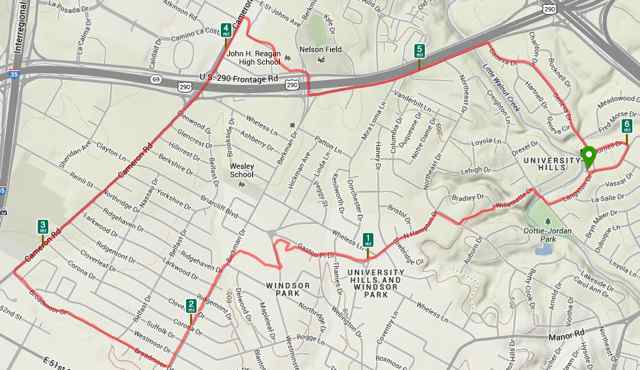 | Mad dogs and Zimmermanns go out in the midday Texas sun — in this case, to ramble past old haunts. The trek today takes me by J. E. Pearce Junior High School, from which I graduated in 1966, and the Windsor Village strip-mall where for several years then I worked in the local Austin Public Library branch shelving books. Sunflowers, mockingbirds, and kids waiting for a bus nod as I pass by. A zig-zag through smaller streets gets me to Cameron Rd near a Taco Bell; sadly I have no money. The big Capital Plaza shopping center is still here from decades past, but the stores that occupy it have almost all changed. I pass Redeemer Lutheran Church, which my Mother is still a member of. This morning the pastor was talking after the service with a Mexican-American lady who reported feeling unwelcome at another congregation: "It's sad," he tells her, "but the Devil works hardest inside these walls." The sermon (based on Luke 7:11-16) begins with Jesus raising a widow's son from the dead, and then turns to focus on the social situation of the widow and how she became a part of society again. It's about connections. Continuing under the US-290 highway I arrive at my high school, John H. Reagan, named for the 19th century Texas politician. It takes some exploration to find an opening in the fence around the grounds. Eventually I random-walk past the big gymnasium where the double-negative motto "Not Without Honor" still graces the wall, along with dates commemorating victories in the Texas State football championship. Then it's a homeward trot along the highway frontage road — sidewalks are wide in Texas, thankfully — and local streets again.. Runkeeper shows 6.20 miles, including a wiggle at the end that I add to make sure the total exceeds 6 safely. |
- Thursday, July 04, 2013 at 05:45:31 (EDT)
^z was valedictorian of the Class of 1970, John H. Reagan High School, Austin Texas; the numbers record years of State Football Championships
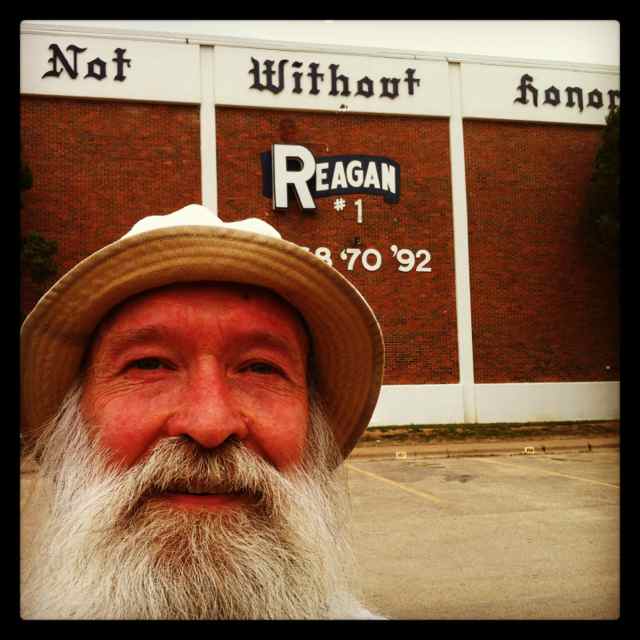
(photo taken 9 June 2013 at mile ~4 of a hot summer jog around the neighborhood ...)
- Wednesday, July 03, 2013 at 04:27:32 (EDT)
Owen Flanagan in Chapter 4 ("Being No-Self and Being Nice") of The Bodhisattva's Brain resolves a seeming paradox of "the doctrine of emptiness", which says that everything — including "my consciousness" — is mutable and non-permanent. Thus, the Buddhists argue, "... the wise person sees herself as no-self, as atman-less. ... One needs to absorb and eventually live this truth. ..." Flanagan speculates that a no-self will be less attached to things and experiences, and therefore will suffer less, will be more tranquil, more peaceful, more serene.
But if emptiness itself is a "thing" then there's a problem. Emptiness would exist unchanging and unconditional, a violation of the doctrine of emptiness. The answer Flanagan offers is from mathematical set theory:
But here we can get help from something like Bertrand Russell's theory of types. When I assert that "All things are empty," I seem to need to assert next that emptiness is empty. But not if emptiness is not a thing. That is, if emptiness just means that no thing has intrinsic existence, is self-originating, and so on, then I've said all I need to say by asserting that "All things are empty," because lacking intrinsic existence, not being self-originating, is just what the state of being empty is or, better, means. The state of being empty is not a new thing that itself has to be accommodated by the doctrine of emptiness. Alfred North Whitehead, Russell's pal, the Anglophone "process philosopher" par excellence, warned of "the fallacy of misplaced concreteness" in his attack on substantialist metaphysics. Nagarjuna's mistake is taking emptiness to be a thing. It is not. Emptiness is just the predicate that says things don't have thingness in any deep sense. So emptiness itself, being of a different type than "things," does not itself fall to the same deconstructive logic that all things do.
That's a powerful mental tool, applicable in other contexts. Alas, Flanagan continues to beat the horse for a couple of additional pages. Maybe that's just what philosophers do ...
(cf. Believing in Leprechauns, ...)
- Tuesday, July 02, 2013 at 04:11:01 (EDT)
In recent months (make that years?!) far too many tidbits have accumulated on index cards I carry around with me, on bookmarks tucked into half-read tomes, in scrapbook pages here on ZhurnalyWiki, in Twitter and Facebook link-posts, etc. Time to try to take that those small quanta of thought and toss a few handfuls at the wall, to see what sticks ... or at least, make them findable again, even if they don't rise to the level of musing-essay-worthy. An initial core sample:
- "A Rational Design Process: How and Why to Fake It" — an essay by David Parnas and Paul Clements, something to read some day — a great title that shows healthy cynicism (and the tug-of-war between the words "rational" and "fake") — see Wikipedia:Waterfall_model. WickedWork, etc.
- "Sudelbücher" — a cute German word for "scrapbooks" or more literally "waste books" — see Wikipedia:Georg_Christoph_Lichtenberg for information about Lichtenberg's notebooks which he called that
- Gerd Gigenrenzer — a German psychologist who has written about "calculated risks" and other topics that might be good to study more of — see Wikipedia:Gerd_Gigerenzer
- "gamification" — and the myth (or common perception) that if one can just turn a dull or difficult task into a game, then one can for free get unlimited resources to solve it — ignoring the finiteness of resources in the world, and the fact that luring people into spending more time on one thing generally steals time for it from other pursuits — like the "piece of the stomach" wars between various snack food manufacturers, and charity fund-raising events — note however that some "crowdsourcing" could be a different beast, especially if it involves tapping into and bringing together scattered knowledge
Perhaps some day some of these can be promoted into ZhurnalyWiki pages of their own?
- Monday, July 01, 2013 at 05:53:45 (EDT)
~8 miles @ ~9.7 min/mi
| Sunrise speedwork at LBJ High School track: a rickety ladder of 1-2-3-4-3-2-1 laps with times 1:49 - 3:49 - 5:38 - 7:03 - 5:32 - 3:28 - 1:37 — pushing hard for the central nearly-a-mile 1600m blitz but not quite hacking sub-7 minutes. The morning's run begins and ends in northeast Austin Texas at my Mom's home. Fences are repaired around the athletic fields but there are still big openings. A young blonde lady is walking in lane 5, with sporadic jog intervals, as I arrive. Morning heat and humidity force my shirt off to reward, or likelier punish, her. She leaves as I reach the middle lap of the interval training. My shadow stretches long across the track. See Austin Kicking High for a mural on one side of the Wilhelmina Delco Center that I detour past during the way home. Runkeeper records the route. | 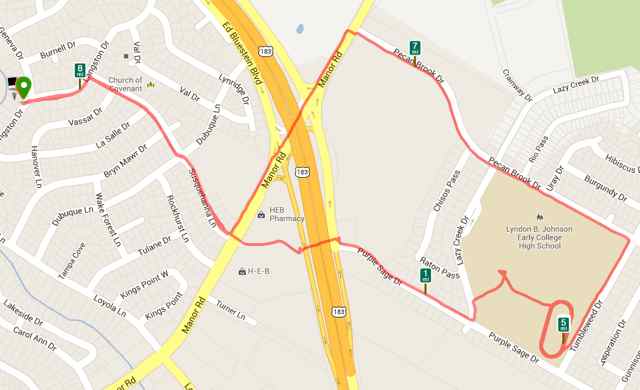 |
- Sunday, June 30, 2013 at 05:07:41 (EDT)
At LBJ High School Track, Austin, Texas, on 8 June 2013:
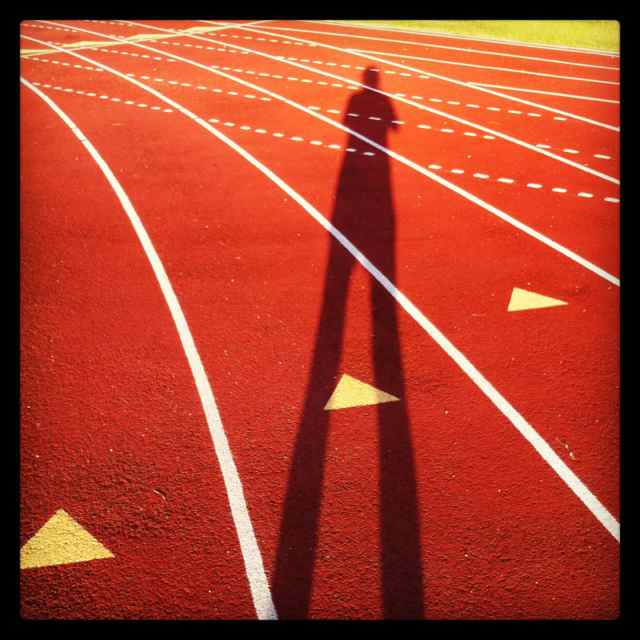
- Saturday, June 29, 2013 at 04:11:31 (EDT)
Oliver Burkeman's book The Antidote: Happiness for People Who Can't Stand Positive Thinking is by turns clever and frustrating, slow and insightful, repetitive and credulous. It could be called The Anecdote for all its reliance on unsupported seems-like-it-should-be argument based on idiosyncratic one-of-a-kind experience.
But what's it all about? The Antidote grew out of Burkeman's "This Column Will Change Your Life" series of essays in the British newspaper The Guardian. It focuses on "negative thinking", the notion that perhaps by looking at the worst-case and meditating on the bad, one could come to better appreciate what's really good in the world. Key front-and-center classical examples of this? The philosophies of Stoicism and Buddhism, which feature prominently in early chapters and to which Burkeman often returns in his analysis of New Age movements, self-improvement gurus, success counselors, and the like.
There's much to salute in The Antidote. Unfortunately, there's also much to criticize. Most frustrating: a general lack of crisp, metaphorical-lovely language and imagery. Secondarily: after a few (dozen) uses, the turn-it-on-its-head device of finding the negative in every positive gets rather predictable. Burkeman's tales of his personal expense-account travels and meetings with various semi-celebrities also fail to persuade. And it's a stretch, ill-connected to the book's central theme, to devote a chapter to failed business products (some of which actually succeeded at different places and times).
Perhaps, as wise friend Dana B gently points out, I've already read too much on some of these topics and I come to The Antidote wish glazed eyes? And yes, there are exceptional quotes worth remembering; examples to follow in later posts here.
- Friday, June 28, 2013 at 04:40:11 (EDT)
In Chapter 4 ("Satan—The Adversary") of Living with the Devil Stephen Batchelor suggests the source of what he (rather mystically, throughout the extended musing which comprises this book) calls "The Devil":
"For the demonic," reflects the theologian Paul Tillich, "is the elevation of something conditional to unconditional significance." Each time something contingent and impermanent is raised to the status of something necessary and permanent, a devil is created. Whether it be an ego, a nation-state, or a religious belief, the result is the same. This distortion severs such things from their embeddedness in the complexities, fluidities, and ambiguities of the world and makes them appear as simple, fixed, and unambiguous entities with the power to condemn or save us. Far from being consciously chosen by individuals, such perceptions seem wired into the structure of our psychological, social, religious, and biological make-up.
What this precisely means is unclear, to put it gently. Is "Satan" the right word for reification, the act of treating an abstract concept as if it were something real? That doesn't seem to be its usual meaning.
- Thursday, June 27, 2013 at 05:35:42 (EDT)
~10 miles @ ~9.7 min/mi
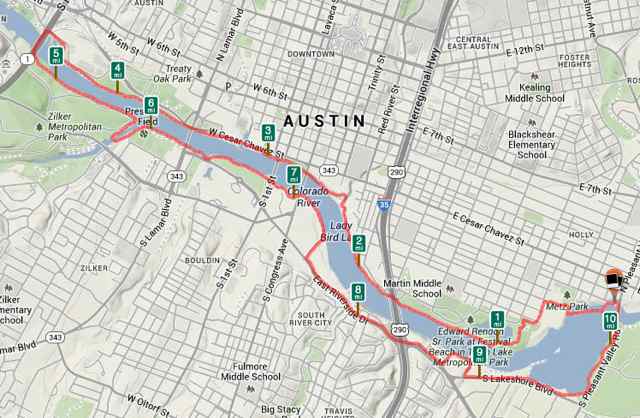 | Whew! Texas-class heat and humidity hammer away during a Lady Bird Lake loop starting at sunrise. The Planet K head shop is artfully lit as I pass by on my way to park at the dam which forms the east end of the lake. I stop across the street and take photos. I'm in Austin to visit family for an extended weekend. The plane landed yesterday afternoon. Young women in primary-color jog bras pull me along during this Friday morning run. I'm embarrassed to be caught walking. Last month the local running-supply company RunTex, bankrupt, held a final liquidation. So there are no longer free water stations at various points along the lake pathway, just city-park fountains, some of which work. Splits are a brisk 10:48 (including a quick porta-john visit near the ballfields) + 9:29 + 9:31 + 9:32 + 10:01 + 9:15 (chasing a lady in black) + 9:20 + 9:45 + 9:21 + 9:07 (smelling the finish line) and a final fraction across the dam, stepping aside to let a bicycle pass, at 9:36 min/mi pace according to Runkeeper. |
(cf. 2010-07-16 - Lady Bird Lake Loop , 2010-09-22 - Lady Bird Lake Loop , 2011-05-25 - Lady Bird Lake Loop , 2011-05-27 - Two Austin Town Lake Loops , 2011-05-29 - Last Lady Bird Lake Loop , 2012-01-14 - Lady Bird Lake Loops , 2012-01-16 - Lady Bird Lake Loop CCW , 2012-09-03 - Lady Bird Lake Loop - Austin Texas, 2012-09-05 - Double Lady Bird Lake Loop - Austin Texas , 2012-09-07 - Zig-Zag Lady Bird Lake Loop - Austin Texas , 2013-01-18 - Lady Bird Lake Loops , ...)
- Wednesday, June 26, 2013 at 05:15:09 (EDT)
During recent months I've had sporadic online conversations with Macy Cronkrite, at that time a MITRE software developer and computer scientist. My habit during our chats of quoting from ZhurnalyWiki led her to suggest that I was actually a "chatbot", a computer program that emulates a human being. One such dialogue:
gm Macy!(*)
morning mark - how you doing?
not bad, tnx --- was just reading and sharing with runner-friend here the essay [1]
body-image, collision of goals (thin but strong), etc.
interesting - I like this take on body goals over the two
extremes of don't eat and (don't watch what you eat)
because some people think the body image against fat is unhealthy.
Not sure how i feel about that when you see peole who are fat and proud.
I know its good to be proud, but not sure it's healthy at any level.
agreed! --- "moderation in all things" and "the middle way" etc.
I used to argue with a friend over "fat" vs. "fit"
swim coach for my kids used to tell them, "It's ok to be BIG, but you've gotta be STRONG"
thats good quote
quoted in ZhurnalyWiki of course
ChatBot needs Google Glasses that pop up apropos ZhurnalyWiki quotations based on the words it's thinking
:D
I like the quote from Rick Hanson in Strong and Lasting
ha! - found it - at end of BigAndStrong
ChatBot status returning to <idle>
LOL:D
your joke, ChatBot is just echoing it
must put something into ZhurnalyWiki on this theme, so I can quote it meta
LOL that's too funny
"Anything you can do, I can do meta" DoMeta --- 1999
<:o)
<<partying like it's 1999>>
hmmm, maybe I really AM a ChatBot
meat-based
"meta" in this context means beyond nice --- it's true:)
and "meta" is an anagram for "meat"
...
Yes, and maybe it wouldn't be too hard to write a little software that runs in background against the ZhurnalyWiki (or other collection of apropos material) watching for correlations with terms that come up in dialogue, and providing links to that for easy use?
Hmmm, and maybe I really am a meat-based ChatBot? — a collection of algorithms that pattern-match against stuff that I've heard in the past?
(ChatBot suggests TopicMind, and especially GetWet, MessyAndNeatCategories, or possibly MetaMan.)
- Tuesday, June 25, 2013 at 04:46:14 (EDT)
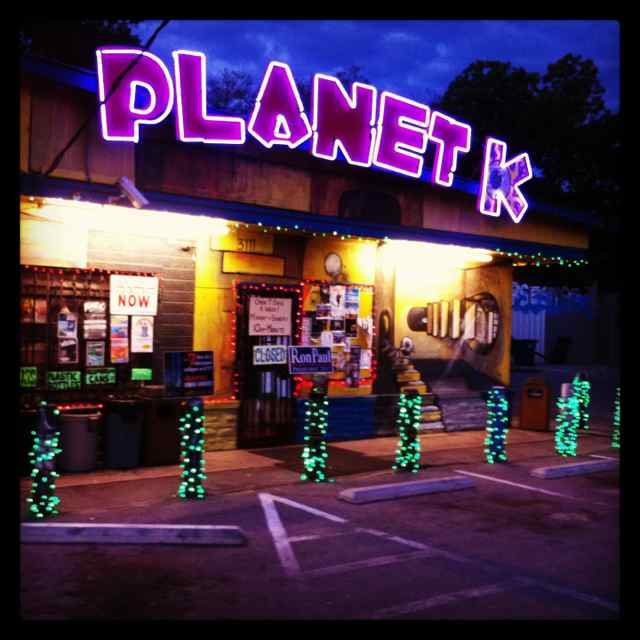
Sunrise on "Planet K", a head shop that I see brightly lit on my way to run around Lady Bird Lake in downtown Austin Texas. As the advertisement describes it, Planet K is:
| Featuring the best selection of imported cigarettes, pipes, vaporizers, incense, underground books, erotica & more |
... since 1990!
- Monday, June 24, 2013 at 04:08:14 (EDT)
~2.9 miles @ ~10 min/mi
Torrential rains at 5am turn into drizzle at 6 and are almost stopped by 7. I'm heading out from the MITRE-1 loading dock as Amber Sprenger appaers, ditches gear in the locker room, and joins me. Kerry Buckley arrives and we set out together on the usual Anderson - Pimmit - Griffith - Magarity urban orbit. I chatter away, entertainingly (I hope!) and Runkeeper says our splits are faster than Amber & Kerry anticiapted, 9:55 + 9:52 + 10:06 min/mi for the final fraction.
- Sunday, June 23, 2013 at 06:16:23 (EDT)
At the end of Chapter 3 ("Buddhist Epistemology and Science") in The Bodhisattva's Brain Owen Flanagan summarizes what he sees as the best position to hold about the metaphysics of consciousness:
A live option is this: keep an open mind about how conscious mental states are realized neurally, while assuming that they are. Once upon a time there was a view that there would be neat one-to-one mappings between the phenomenal and the physical. There is still some hope for identity theory for sensations. But almost no one believes that identity theory will work for more complex states. The judicious strategy is to wait and see how the mapping goes. It is likely to be very complex, with bridge principles that will need to be invented. And come what may, no nasty reductionist or materialist will be in any position to say that consciousness is an illusion or that you don't make choices (although he can say truthfully that you have no free will in the libertarian sense). That said, the best hypothesis is that the conscious mind is the most complicated biological phenomena ever studied. It is precious and beautiful and is part of the natural fabric of the universe. There is no longer any need for bewilderment, befuddlement, or mysterianism from Buddhism or any other great spiritual tradition in the face of the overwhelming evidence that all experience takes place in our embodied nervous systems in the world, the natural world, the only world there is.
(cf. ThoughtfulMetaphors and other commentary on mind by Daniel Dennett et al.)
- Saturday, June 22, 2013 at 04:11:05 (EDT)
~4.5 miles @ ~19 min/mi
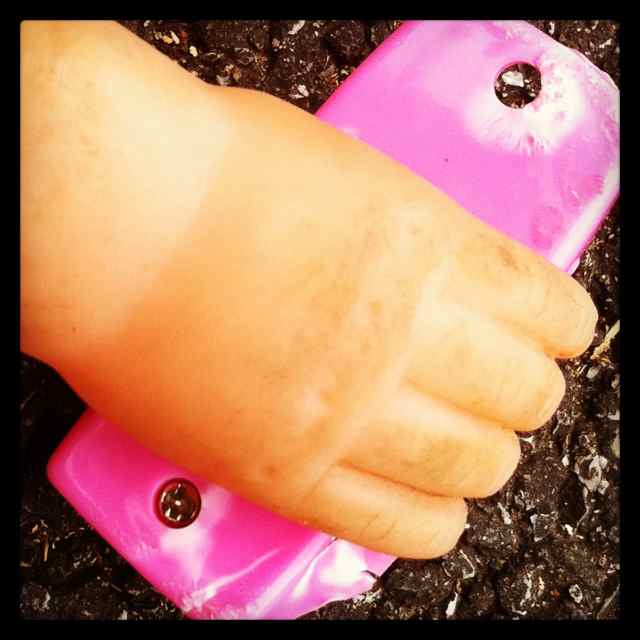 | In the final mile of our figure-eight trek on the trails of WRP dear friend Caren Jew and I see a severed hand on the pavement, clutching a cellphone. What is its story, we wonder? Early today I practice cross-training for an hour by attempting to mow the lawn at New Place with a mechanical push-mower. I learn a lot about how to unjam the reel (rotate the blades back an inch using foot or hand so the twig falls out), the best time to mow (early, before the sun begins to beat down), and the best pattern to follow (as in artistic drawing, a fractal route so that one may quit at any time and have a plausibly-incomplete sketch of a finished job). Hmmmm, perhaps gloves would be wise too; I develop a small blister on my thumb from the lawnmower handle. Maybe I should stay home from work tomorrow? To recover I sit on the front porch, drinking a Diet Coke over crushed ice and reading The Philosophers' Magazine. Caren arrives at New Place and after a tour of the back yard and the still-mostly-empty rooms we're ready to run. I ask the proper color-name for her pretty shoes, and she tells me simply "Purple!" We discuss the nuances of violet vs. indigo. Four miles later, when I hold the anti-deer gate open for a couple to walk out behind us, the tattooed lady of the pair admires Caren's shoes. She sports brilliant hair, dyed turquoise, that matches her blouse, shoes, and socks. I'm clad in a slimming-gray "Lean Mean Running Machine" technical shirt, a gift from Caren long ago, accompanied by the black-and-green Seneca Creek Greenway 50k shorts that were finisher's prizes when Caren and I ran her first ultra together (cf SenecaCreekGreenwayTrailMarathon2006). The woodsy pathways in WRP are a lovely delight, as is our trail talk. At every turn we're surprised by dog-walkers. Five people practice Tai Chi by Pine Lake. I whisper to Caren that I'm skeptical of qi energy and acupuncture in general as a cure for cancer and the like, but could accept it possibly affecting the ill-understood autonomic nervous system. Crowds of slow-walking tourists intermittently block us inside the gardens. Runkeeper credits us with 4.55 miles @ ~18.6 min/mi but the Garmin is more conservative and only says 4.36 miles @ ~19.4 min/mi pace. |
- Friday, June 21, 2013 at 04:08:13 (EDT)
A wise friend suggested recently that when, over the years, a couple's relationship changes radically, perhaps one skillful way to think about the new situation is the mantra:
Things aren't the same any more. They never are. It's less helpful to compare now with then. The honeymoon's over. But before the honeymoon could begin, the courtship had to end. Each phase is good, but different from the one before. Relative ranking as better or worse isn't useful. Hmmmmm!
- Thursday, June 20, 2013 at 04:16:53 (EDT)
In The Atlantic magazine a few months ago James Parker wrote a beautiful essay, "Reliving Groundhog Day." The subtitle-summary says, "On the 20th anniversary of the beloved Bill Murray comedy, it's time to recognize it as a profound work of contemporary metaphysics." Maybe he's right. Harold Ramis and Danny Rubin, writers of Groundhog Day, certainly came up with something fantastical, which the actors (Murray, Andie MacDowell, et al.) and director (Ramis) and collaborators made real. It's a Kafkaesque story of Phil, a TV weatherman, stuck in a loop, starting the same day over and over again, with no exit ... until he stops scheming and clinging and just is. Parker concludes:
But Phil learns. He learns contentment, and he learns forgiveness, and he learns kindness. He sits in the Punxsutawney diner, happily reading—but he's not just reading, he's radiating Buddha-nature. It's all expressed in the trajectory of his relationship with Rita. He wants her, he tries to seduce her—first with meanness, then by fraud, then with recitations of French poetry and engineered perfect moments. It is only when he gives up, when he accepts the blessing of her company, free from desire—at which point she, too, magically becomes a far more interesting character—that she is delivered into his arms. Oh, it deepens with every encounter, this movie. I watched Groundhog Day twice while writing this column. I think I need to watch it again.
- Wednesday, June 19, 2013 at 04:32:56 (EDT)
~22 miles @ ~12.5 min/mi
I pause to read the park sign at the Northwest Branch Trail crossing of Colesville Rd. On 21 June 1904 President Theodore Roosevelt wrote to his son:
Mother and I had a most lovely ride the other day, way up beyond Sligo Creek to what is called North-west Branch, at Burnt Mills, where is a beautiful gorge, deep and narrow, with great boulders and even cliffs.
Excepting Great Falls it is the most beautiful place around here. Mother scrambled among the cliffs in her riding habit, very pretty and most interesting. The roads were good and some of the scenery really beautiful.
We were gone four hours, half an hour being occupied with the scrambling in the gorge.
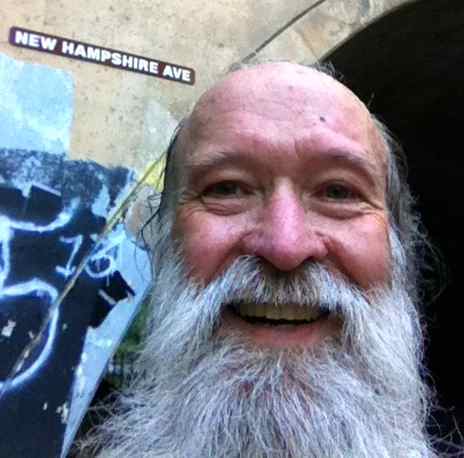 | From New Place at 5:25am I trot the block east into Wheaton Regional Park. Two dozen geese with gray goslings part their flock to let me pass through near Pine Lake. As usual I take wrong turns and meander on the tangle of trails. A big deer pops her head up to eye me from concealment in waist-high grass. Another pair of deer startle and flee at my approach. Eventually I stumble upon the park maintenance area at Alpert La near Kemp Mill Rd. Then suddenly I'm back on the horse trail that Mary Ewell and I took less than a week ago (cf. 2013-05-26 - Wheaton Regional Park with Mary). It leads to Northwest Branch Trail, where from this direction the correct detour is apparent: just follow the outside of the fence past construction equipment. A fellow early-bird runner on Kemp Mill Rd waves at me as I cross in front of him. Heat and humidity are already notable as the temperature prepares to rise toward 90°F later today. Soon blue shorts and Red Sox mesh shirt are sweat-soaked. Downstream a couple is walking a giant fuzzy black dog that looks almost like a bear. It sniffs and nuzzles me. I debate cutting the run short at Colesville Rd, at Piney Branch Rd, and at East-West Hwy, but decide to continue. It seems craven to stop early when Ken Swab, Rebecca Rosenberg, and Barry Smith are doing the North Face Endurance Challenge 50k, and Stephanie Fonda and Marshall Porterfield are attempting the 50 miler. (What kind of a wimp am I, anyway?) I slow to scramble over the "Fall Line" section of Northwest Branch, where according to the Park Service sign "... the tough metamorphic rocks of the Piedmont, meaning 'foot of the mountain,' give way to the sandy sediments of the coastal plain." This is also called the "Torrent and Gorge" section of the trail. (Maybe it should be "Torment and Gorge"?) After scrambling over boulders and narrowly keeping my footing on some slippery stones I go under the I-495 Beltway and reach the paved section of the trail. Dear friend Rayna Matsuno texts me as I approach New Hampshire Av. We exchange messages. I send her a quick photo of the tunnel under the road, with graffiti partially blocked by my ugly mug. I take a Succeed! electrolyte capsule in her honor: Rayna and I first met at the Seneca Creek Greenway Trail Marathon 2005 when she gave me an S! cap and saved my race. Thanks, Rayna! |
| At the cricket pitch, my mile ~10 and milepost 4.5 of NWB, the fountain is too weak to fill my hydration backpack's bladder. But I get a bit more water into it, and pause at later fountains to drink as much as possible. Nonetheless, by mile ~19 I'm sucking on fumes. At the first bridge on Sligo Creek Trail, near where it joins Northwest Branch, there's an apparently handmade cross decorated with an artificial flower and green ribbons, new since I was last here two weeks ago (running the opposite direction; cf. 2013-05-18 - Sligo Creek - Northwest Branch - New Place Loop). I send the photo to Rayna, who speculates that someone passed away here. My pace slows now, and the density of other runners and walkers increases. I take S! every hour, nibble on a crunchy peanut Clif Bar, suck a root beer barrel and an atomic fireball candy, and eat my last mini Heath Bar. To no avail, however — the swelling of my fingers suggests either dehydration or electrolyte imbalance. Walk breaks increase in frequency and duration, but the cumulative average pace continues to creep down from ~14 min/mi (on the natural-surface rocky trail for the first half-dozen miles) to eventually sub-12.5 min/mi. Major construction work is underway to improve the trail bridge over Sligo Creek at New Hampshire Av. Near the Silver Spring International Middle School a young child on a bicycle, one eye bandaged over, says, "You look like Santa!" His mother starts to apologize, but I reply to him first: "You're right — a lot of people say that!" A tall runner passes me, then has to jump aside when a dog on a loose leash growls at him. The owner says, "Sorry!" and I tell the runner when he again goes by, "Wow, that really got your heart going, didn't it? You can run fast now!" He laughs. In the final miles a lanky fellow wearing a Qatar Foundation shirt raises his arms to symbolize "Victory"; I do likewise and say, "Go Qatar!" to him. The final block from Wheaton Regional Park to the New Place on is a staggering sprint up the gentle hill. A man sits on the front porch of the last little house on Henderson Av, smoking, and waves at me. He saw me run past and waved a couple of times last week too. Runkeeper and Garmin differ by ~3% in their distance estimates: 22.28 vs 21.62 miles respectively.. | 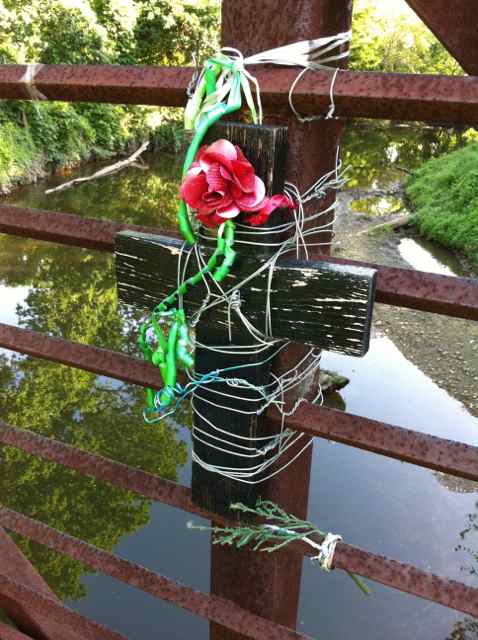 |
- Tuesday, June 18, 2013 at 04:13:19 (EDT)
Chapter 37 ("Tend to the Causes") of the little book Just One Thing by Rick Hanson proposes that we focus more on the causes of things or events, rather than on the outcomes they represent. Hanson advises, "You can relax attachment to results. When you understand that much of what determines whether they happen or not is out of your hands, you worry less about whether they'll happen, and you suffer less if they don't."
That's profoundly liberating, as well as appropriate. And it applies to all fields and endeavors. Train hard, put your heart into the race, and the finish line will arrive at its proper time. Obsessing about the end doesn't fix it; working on getting the beginning right, just might.
- Monday, June 17, 2013 at 04:04:52 (EDT)
~7.5 miles @ ~16.7 min/mi
Barry Smith kindly picks me up at home and accepts my offer of coffee at 7-11. We meet Rebecca Rosenberg at the parking lot near Hardware City but follow her back to her home to avoid threatened towing for cars left by non-shoppers. On Georgetown Pike we park at the Fairfax Cross-County-Connector trail lot and proceed downstream along Difficult Run to near where it meets the Potomac River. Erosion damage and hazardous terrain forces us to backtrack and scramble up to take the Ridge Trail and then the River Trail to the Great Falls National Park visitor center. Flocks of hikers, walkers, and picnickers cross our path. Disappointment ensues when the snack bar is closed and I can't buy candy. We continue upstream, previewing the North Face Endurance Run course for next week's race that Barry, Rebecca, and other friends are tackling. The Old Carriage Road then gets us back to our starting point. A mountain biker recognizes me from the VHTRC and introduces himself with: "I'm Gary Knipling's son-in-law!" We continue upstream on the F-CCT and cross Difficult Run on giant stepping-stones. Post-trek dehydration shows up as '138.8" lbs on the digital scale, a near-record low. Runkeeper and Garmin map the route.
- Saturday, June 15, 2013 at 05:07:03 (EDT)
In Chapter 1 ("Parallel Mythologies") of Living with the Devil author Stephen Batchelor explores emptiness as "... an absence of what limits and confines one's capacity to realize what a human life can potentially become":
At the heart of Buddha's awakening lies a counterintuitive recognition of human experience as radically transient, unreliable, and contingent. By paying sustained, unsentimental attention to life as it unfolded within and around him, Siddhattha Gotama (the historical Buddha) realized that no essential self either underpinned or stood back and viewed the integrated display of colors, shapes, sounds, sensations, thoughts, and feelings that arise and vanish in each moment of consciousness. This startling insight shook him to the core of what he felt himself to be. The instinctive conviction of being an unchanging, isolated "I" collapsed. Life was just a dazzlingly tentative array of contingent processes, playing themselves out in complex sequences of causes and effects but with no discernible beginning and no divine power mysteriously directing them to a preordained end.
... and, a couple of pages later:
Letting go, even momentarily and unintentionally, of that desperate and obsessive grip on self does not obliterate you but opens you up to a fleeting and highly contingent world that you share with other anxious creatures like yourself. This can be frightening; for the only certainty in such a world is that at some point you will die. You realize that your self is not a fixed thing or personal essence but a tentative and confused story hastening toward its conclusion. This might prompt you to scurry back to the familiar perceptions, beliefs, and routines in which you feel secure. But once the process of emptying has started, to cling to such consolations will hinder you from feeling fully alive. To become empty, as Nagarjuna insists, is to encounter the raw, unfiltered contingency of life itself. The challenge of emptiness is to plunge into life's torrent rather than hover uncertainly on its brink.
... maybe like the Bob Dylan lyric in Mr Tambourine Man, "... but for the sky, there are no fences facing ..." — and the Chuck Palahniuk Fight Club observation "And then, something happened. I let go. Lost in oblivion. Dark and silent and complete. I found freedom. Losing all hope was freedom."
- Friday, June 14, 2013 at 04:22:20 (EDT)
~4.3 miles @ ~14.2 min/mi
Dear comrade Mary Ewell visits my family at the Old Homestead, and then we ride together to New Place and take a rambling tour together of Wheaton Regional Park byways, both paved and natural-surface. Wonderful "trail talk" ensues, extraordinarily therapeutic, concerning our silly lives. (Thank you, Mary — I am truly blessed to have such lovely friends!) We also discuss training plans, triathlon strategy, modern medical fallacies, and nutrition. As we return to Henderson Avenue a speedy buff young fellow passes us and incentivizes Mary to give chase for the last quarter mile. I concur in her admiration of his chiseled calves and upper-body musculature. Runkeeper and Garmin concur to within ~2%.
- Thursday, June 13, 2013 at 07:51:15 (EDT)
~4.5 miles @ ~8.9 min/mi
From the New Place on Henderson Av I take neighborhood cut-throughs (apparently there's a county right-of-way above a sewer line, though some homeowners try to obscure it with shrubbery) to Parker, Hermitage, and finally Arcola. A large rabbit scampers away before I can photograph it. Then it's time to sprint the sidewalks, for a tempo run exploration of the new 'hood. Mile splits: 9:36 + 8:46 + 8:02 + 9:15 + a final fraction at 8:51 min/mi, according to Runkeeper, with Garmin in rough agreement.
- Thursday, June 13, 2013 at 07:46:50 (EDT)
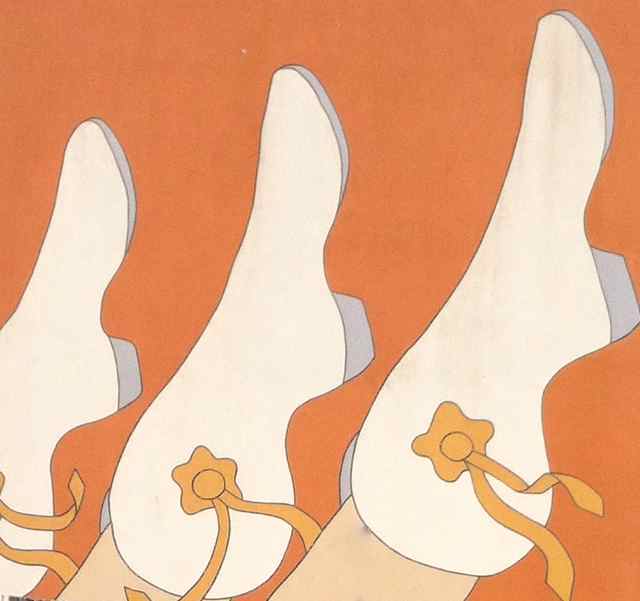
... decoration on the side of the Austin public school system's Wilhelmina Delco Center for sports and activities ...
(cf. 2012-06-10 - Metropolitan Branch Trail to Clair, ...)
- Wednesday, June 12, 2013 at 04:13:33 (EDT)
~18 miles @ ~12.3 min/mi
Starting point: Candy Cane City. Barry Smith and Sara Crum soon run ahead, as Gayatri Datta and I jog along comfortably, with walk breaks and latrine pauses as needed. Gayatri did the Pocono Marathon last week and tells me her story of hills and fog. On the literary front we discuss Indian authors and movies. She and her husband Atin plan to see Midnight's Children, the film version of Salman Rushdie's first novel, tonight. After ~5 miles we tag the gate on Beach Dr at Broadbranch Parkway and begin to retrace our steps. Trail buddy Mike Edwards sees us at the park near Military Rd. Barry and Sara, we soon discover, waited at Pearce Mill for us, about half a mile farther downstream than we progressed. They catch up with Gayatri and me during the return trip.
Gayatri declares victory with ~10 miles when we reach Candy Cane. Sara & I run together upstream, accompanied by Barry until the Capital Crescent Trail trestle. He turns back to log 12+. Sara taunts me about my habit of "tagging" landmarks, and asks what I would do if she tied my hands. "Use my nose!" I reply. We run up the Mormon Temple hill, and I tag the stopsign at the corner of Kent and Stoneybrook to celebrate the ascent. We take Old Spring Rd down, close the loop, and then retrace it in the reverse direction. Sara ends up with her goal of 18.5+ miles. Runkeeper and Garmin roughly concur on my mileage.
- Tuesday, June 11, 2013 at 04:09:40 (EDT)
Owen Flanagan in Chapter 3 of The Bodhisattva's Brain uses an entertaining metaphor to explain why he disagrees with the Dalai Lama and others when they say they "feel" that mind is not entirely a physical neural phenomenon:
... the caveat permits a Buddhist or anyone else to believe pretty much whatever they want especially if the demand is that there is disproof, where disproof means something demonstrative. You, the reader, could believe right now that there are leprechauns hoisting these very letters on the page before you, but who move too fast to be caught in the act. You can't disprove it. ...
So, Flanagan argues, one should not accept what he calls "The Caveat" that some non-scientific people make use of, the distinction between "... not finding something and finding its nonexistence ..." as an escape-hatch for whatever mystical beliefs one would like to maintain.
But alas, as in other areas Flanagan beats this horse for dozens of pages. Maybe that's just what philosophers do ...
- Monday, June 10, 2013 at 04:50:14 (EDT)
~20.6 miles @ ~12 min/mi
"So you got up, put on your shoes, and ran 20 miles — like it was nothing special! Wasn't that your goal nine months ago?" I ask Stephane Fonda after we finish this morning's circuit down Rock Creek from Candy Cane City, then back via the Capital Crescent Trail through Bethesda. Stephanie admits that it was one of her fantasies late last summer. Brava!
Our cool, drizzly day's planning begins at 5:33am when I text a few early-bird friends the message, "run plans today?". Stephanie reports that she opened her eyes, saw my words, and smiled. She had hoped to do a solo journey, testing out new Hoka One One zero-lift highly-cushioned shoes. Her longest prior trek in them was only a couple of miles, so today is a stretch by a factor of seven. Audacious, eh?! Stephanie is recovering from bad illness last week and stressful-long days at the office. I did ~22 miles yesterday (see 2013-05-18 - Sligo Creek - Northwest Branch - New Place Loop). It's a stretch all around.
From the start we deliberately hold the pace back, aiming to keep an average of just under 12 min/mi. Wisteria blossoms hang over Rock Creek, as they did yesterday along Northwest Branch. Chipmunks scurry away at our approach. At the Thompson Boat Center crowds of crew competitors walk around us as we refill hydration backpacks from the garden hose. Ponytails, male and female, catch eyes; I cite my long-ago poem on the topic (SevenManes). We subsist on a skimpy diet of mini Heath Bars, Succeed! electrolyte caps, energy gels, and fragments of Clif Mojo or Luna bars. Conversation is, as always, lovely.
Near the bank of the Potomac I see a wee Loch Ness Monster — Nessie's Bairn? — pop its long neck up to look at us. It resubmerges before I can photograph it. At mile ~16.5, McDonalds in Bethesda on River Road, I divert to buy a senior coffee, then must sprint to catch up with Dr Fonda. When we get to Jones Mill Rd and I start to cross against the light a car zips around the corner. I throw up an arm to block Stephanie and we leap back, narrowly averting disaster.
When Stephanie's GPS reads 20.00 we commence walking, in honor of dear friend Cara Marie Manlandro, who used to refuse to run another step once her GPS reached the day's goal. We do break CM's rule, however, and jog a bit further down Beach Dr near the end of our loop, to ensure that our overall pace stays safely sub-12 min/mi. Debate and banter ensues over which of us is more Obsessive-Compulsive, today and in general. Stephanie drives me back home via the Silver Spring Food Coop, where I buy fancy coffee beans for a friend's daughter's wedding gift (and weeks later, still owe Stephanie $69+ in reimbursement). Post-run digital scale readout shows a dehydrated 139.9 lbs.
Runkeeper grants us a bonus half-mile or so, probably from glitching at the Dalecarlia and Wisconsin Av tunnels when the GPS satellites are out of sight, for an estimated total of 21.26 miles. Garmin says our distance is 20.64 mi.
(cf. 2012-09-23 - Rock Creek CCT Loop with Stephanie and Gayatri, ...)
- Sunday, June 09, 2013 at 08:15:05 (EDT)
Near the end of Chapter 4 ("Spontaneity") of Impro for Storytellers author Keith Johnstone explains:
The best trick I know for releasing the imagination is to persuade the students that their imaginations have nothing to do with them.
'The imagination is a huge animal with a will of its own,' I say. 'Be interested in it, but accept no responsibility. You're not its keeper. Where do ideas come from, anyway? Why should I say "I thought of it", or "I thought of an idea", as if my creativity was something more than the acceptance of gifts from an unknown source?'
Ultimately students have to accept that the imagination is the true self (as William Blake knew), but it's not easy to grasp this nettle.
- Saturday, June 08, 2013 at 23:19:09 (EDT)
Chapter 34 ("Don't Know") of Rick Hanson's book Just One Thing explores the vital importance of space, of emptiness, of leaving room to grow and learn, of holding back and delaying the tendency to reach a conclusion. Among the exercises he suggests trying are to wait for others to finish speaking in conversation, to observe objects without labeling them, to let go of the urge to grasp at "the answer", and continually to question assumptions and authorities. Hanson concludes with a benediction:
| "May you know less after this practice of not-knowing than when you began." |
- Friday, June 07, 2013 at 06:23:53 (EDT)
~22 miles @ ~11.9 min/mi
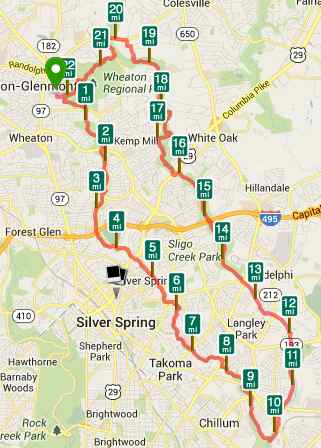 | A dozen nicely-dressed people on Northwest Branch Trail near the Quebec Rd bridge are reading aloud softly in Spanish from small books they carry open in front of them. Bibles? Catechisms? They're followed by another dozen walkers doing likewise, half a block behind. Is it a Pentecost celebration? I smile at them and they smile back. I'm in the middle of a long and pleasant solo trek. At 5:35am I set out from the New Place and turn right at the miniature train tracks to head down Sligo Creek. A large deer peers at me from beside the woodsy path in Wheaton Regional Park. The day is cool, and lots of friendly dog-walkers and fellow runners greet me. Many locations that I've seen before are strikingly verdant and alive this spring morning. I think about friends who haven't been here, and daydream of introducing them to the lovely trail. Upstream along Northwest Branch the rocks and rapids are dramatic but hard to photograph. A stone outcropping forms a crude face behind mine. Chipmunks scamper across the leaves. | 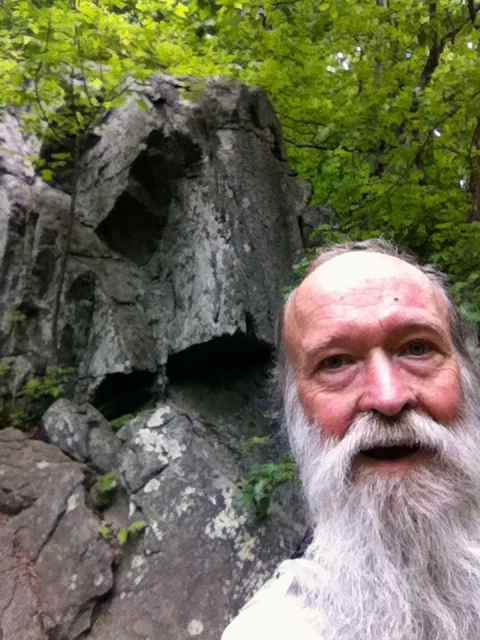 |
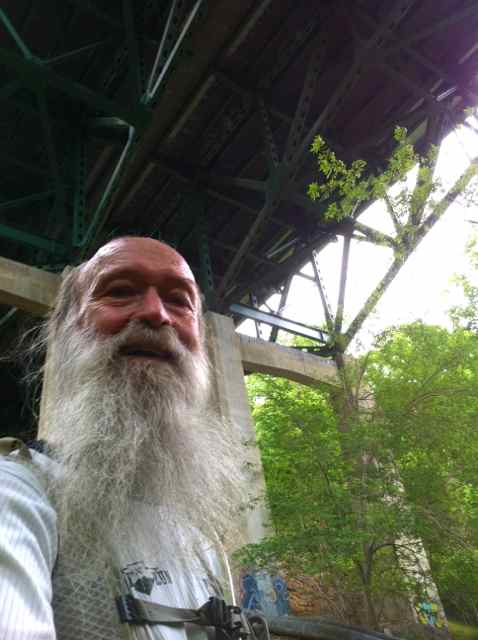 | Violet blossoms of wisteria hang vivid above the creek. Stephanie Fonda teaches me the plant's name when we see it the next day. The Capital Beltway (I-495) bridge is noisy overhead. At the end of the paved trail a pair of crimson-clad University of Maryland student fishermen pick their way cautiously across the boulders and down to the water. A little farther upstream a bicycle leans against a tree and a buff young African-American fellow does Aikido-like ritual exercises. As the trail nears Kemp Mill Rd DETOUR signs confuse me and I end up on neighborhood lanes. I random-walk until I find my way back along major streets to Wheaton Regional Park. A week later the manager at Jerry's Sub Shop in Silver Spring asks, "Didn't I see you running along Randolph Road not long ago?" My sons tell him that I'm often seen on rambles within a ten-mile radius. | 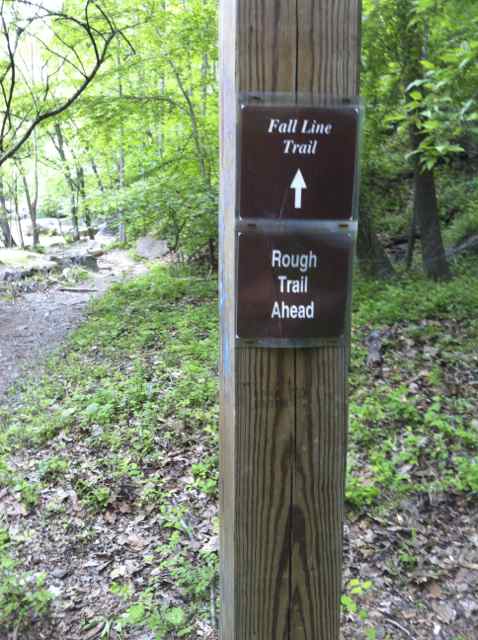 |
Runkeeper and Garmin roughly concur. Splits from the Garmin are 11:25 + 11:18 + 11:55 + 10:50 + 12:06 + 11:10 + 10:42 + 12:04 + 10:43 + 10:35 + 9:58 + 10:32 + 10:15 + 10:39 + 15:34 + 21:15 + 12:04 + 12:06 + 12:17 + 10:33 + 12:21 and 9:47 min/mi for the final fraction.
- Wednesday, June 05, 2013 at 18:02:52 (EDT)
On the Wikipedia page Thermal expansion the section "Expansion in liquids" is, for the past few years, flagged:
| This section requires expansion. |
- Tuesday, June 04, 2013 at 05:49:46 (EDT)
~3 miles @ ~8.3 min/mi
Nobody else shows up at the MITRE loading dock for the 0630 run, so I push off for a solo trek, the Anderson - Pimmit - Griffith - Magarity loop. Pushing a bit, splits are 8:10 + 8:23 + 8:18 by Garmin, and Runkeeper roughly concurs.
- Monday, June 03, 2013 at 10:22:38 (EDT)
"Cosmopolitanism — such a great word! Have you read Camus?" the fellow sitting next to me on the Metro says. He must have glanced over my shoulder as I read the postscript "Cosmopolitanism and Comparative Philosophy" of The Bodhisattva's Brain: Buddhism Naturalized by Owen Flanagan. We chat, and I learn that William is also a fan of Rumi, the Sufi poet who has recently appeared on my far-too-long must-read list. I express skepticism about big-city life for some people, who can't handle the unnatural stress and would be healthier in a small one-church village. "That's just where I escaped from!" William tells me. His verbal and physical mannerisms are — how to put this delicately? — reminiscent of what a dear friend calls "the Small Spoon" if two men are cuddling in bed. At the NOMA Station as he leaves the train we shake hands, limply.
But back to the book. Picking at scabs? Quibbling over words? Displaying philosophical arrogance? Flanagan does each of those a few times too often for Bodhisattva's Brain to be great. Maybe it could have been a few excellent short essays, but then it wouldn't have been publishable. At intervals the author, a Duke University philosophy professor, tosses in dry humor, sharp insights, and thoughtful advice. But he can't resist interminable wrestling matches with definitions of terms, repetitive lists of categories, name-dropping, self-promotion, and densely inconclusive "That said, ..." point-counterpoint.
That said, when he comes up for air in the final pages Flanagan suddenly becomes a first-person human being again. He talks about his problems with Buddhism: ethics that focus on compassion rather than justice as fairness; a tendency to attract passive-aggressive narcissistic followers, especially in the West; and the failure to explain why, if everything is impermanent, what "... makes a life of maximal compassion more rational than a life of hedonism." But Flanagan isn't a Buddhist. He disagrees strongly with mystical non-scientific aspects of that faith, including rebirth, karma, etc. His conclusion:
... Philosophy's contribution is to examine the great traditions of the past for useful insights into what to do now and next. For that purpose, for going forward, Buddhism has something to offer. Is it the answer? Of course not. Nothing is the answer. This is something Buddhism teaches.
Tres Zen, no? Other excerpts, perhaps, to follow ...
- Sunday, June 02, 2013 at 14:26:15 (EDT)
~3 miles @ ~7.6 min/mi
Purple chalk squiggles mark ridges on the sidewalk where runners might trip. Officially it's a "5k", but both of my GPS units put it a bit shorter. MITRE/McLean where I work holds an annual health-promotion "fun walk/run" and I join several dozen colleagues to do it at noon today. Big raindrops splatter the parking lot as we register, and then the sun comes out to make it just a trifle warm and humid. Mile splits according to Runkeeper are 7:09 + 7:43 + 7:51 — Garmin splits are 7:34 + 8:03 + 7:45. Pre-race I chat with triathlete Eileen Boettcher and tell her of my plan to do the first couple of miles at ~7.5 min/mi pace, then see how I feel. But when the young folks dash off at the "Go!" signal I give chase too enthusiastically.
Bottom line: 9th place overall, official finish time 23:02, likely first among the over-50 gang but apparently no ages are recorded. I give my race t-shirt to colleague Kristin who is recovering from recent surgery and can't run again yet.
- Saturday, June 01, 2013 at 16:38:27 (EDT)
~13 miles @ ~11.4 min/mi
At 0630 as I round the corner of my block a rabbit sees me, flinches, then flees to hide and eye my passage from between aisles of daffodils. Squirrels likewise scurry away at my approach. At 0655 I find Sandra Yerkes waiting in her car at Candy Cane City parking lot, decked out in a bright lime-green shirt that says "SAM". Gayatri Datta arrives shortly thereafter, and we begin an upstream trek along Rock Creek Trail. Others plan to run at 8am, but we're moving well together and continue on five miles, turning back a bit before milepost 6. Conversation includes an analysis of macho manly banter, a conference Gayatri attended recently, plans for upcoming races, and the diversity of supplies that I carry in my hydration backpack. At the base of the Mormon Temple hill I part ways with Sam and Gayatri to run up Stoneybrook Dr and take a northern route home via McKenney Hills Neighborhood Park. My weight is down ~2 pounds, to just above 10 stone, after I get back from a ride with DS Merle to the Silver Spring Farmers Market to pick up the weekly grocery box and other goodies. Runkeeper shows the route, with mile splits 10:04 + 10:09 + 18:22 (waiting at Candy Cane) + 11:11 + 10:23 + 11:10 + 11:30 + 11:36 + 11:39 + 10:40 + 10:50 + 10:24 + 9:43 (final blitz with examination of newly rebuilt railroad crossing).
- Friday, May 31, 2013 at 05:03:57 (EDT)
In a nutshell: "Thoughtless Elitism". The Longest Race is (like Scott Jurek's Eat and Run) one of those frustrating autobiographies that one would love to love, but can't. Author Ed Ayers is a superb runner and a long-time publisher/editor/writer. In 2001 at age 60 he set an age-group record in the JFK 50 Miler. That race provides the chapter-by-chapter framework of this 2012 book. The skeleton, alas, isn't strong enough to carry the load. Ayers attempts to connect long-distance running to world peace, ecology, and other big-picture issues, but fails to convince. He drops names and praises race directors to excess. His prose is competent in small doses but cloys as the book progresses. The Appendix "Notes for an Aspiring Ultrarunner" might help a potential champion but is likely to be risky business for most. ("While 30-40 miles per week is a minimum, you'll probably be better off gradually working up to 60-80 mpw.") Let the reader beware.
- Thursday, May 30, 2013 at 06:57:46 (EDT)
~2 miles @ ~9.2 min/mi
Speedwork at the University of Maryland track while DD does Friday evening dress rehearsal for tomorrow night's concert: six 400m repeats (wish it had been ten!), locked in by the grounds crew, climb the fence to get out. Splits: 1:46 + 1:40 + 1:39 + 1:43 + 1:41 + 1:37 — and then, the reward: Marathon Deli for dinner! Runkeeper shows the boring oval trackfile map.
- Wednesday, May 29, 2013 at 05:09:29 (EDT)
~6.6 miles @ ~11 min/mi
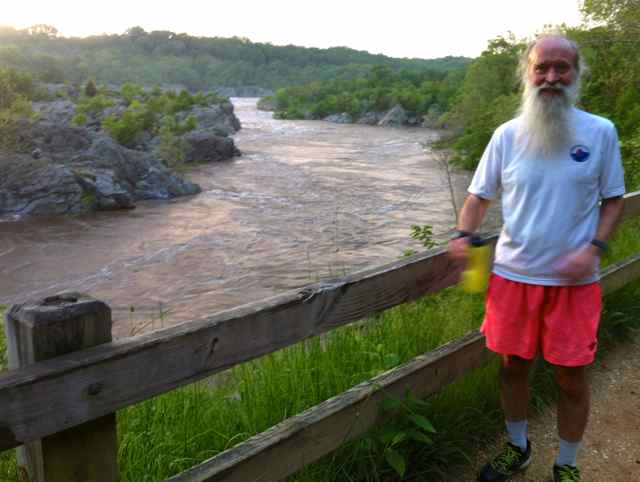 | Kind Barry Smith picks me up and we cruse the Beltway to Carderock where we arrive at 7:40pm, about 10 minutes after the main MCRRC Thursday evening group has departed. Weather is sultry; bicyclists cruise the towpath and fishermen eye the waters. We run upstream, cross a bridge, climb the steep steps, and take a crushed-stone road. The kayak class below decorates the canal with primary colors. We descend to towpath and continue outbound to near a scenic overlook, pause for photos, then turn back as light showers are followed by rumbles of thunder, heavier rains, and finally torrents. The deluge washes salty sweat into my eyes and almost blinds me for a minute. |
| A kayak instructor tells everybody to get off the water, and students begin madly paddling to their launch area. A lightning flash startles us, with the crack-boom less than 2 seconds later. Back at the car Barry changes and I wring the water out of my shirt. Barry drops me off at the house DW Paulette and I bought earlier today. It's similar to our home for the past 30 years but about 4 miles north, a block away from Wheaton Regional Park. I call it "New Place" after Shakespeare's home in Stratford-on-Avon. | 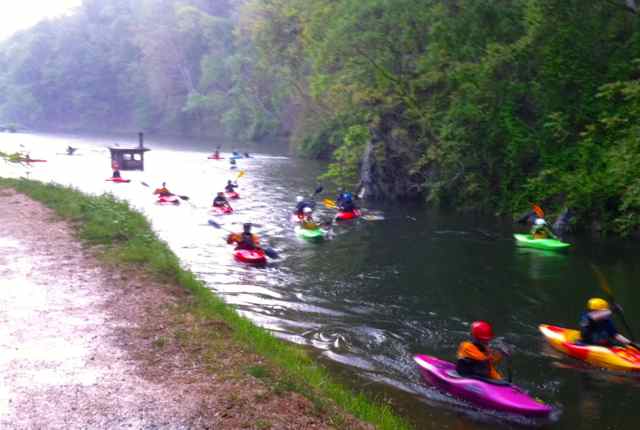 |
Runkeeper logs the trek as just under 11 min/mi with ~100 foot climb to the high gravel side road segment; the Garmin GPS track agrees.
- Tuesday, May 28, 2013 at 03:59:39 (EDT)
~8 miles @ ~11.8 min/mi
Cinco de Mayo Sunday: mid-afternoon Barry Smith and I set off from his home on Belevdere St and follow the connector path to Sligo Creek Trail. Upstream we trek, past a drummer thumping in the meadow at University Blvd. In Wheaton Regional Park we curve west around the ballfields, leave the park to take Hermitage Av, and then cut through on right-of-way paths to Henderson Av where we go by the house — I call it "New Place" — that DW and I plan to buy this month. The current owner is out front and shakes our hands. Then back to the park, across the miniature railroad tracks, past Pine Lake and the dog park we loop. Downstream when we're almost back to his neighborhood Barry shows me a natural-surface trail that leads along Wheaton Branch, a tributary stream to Sligo Creek. We follow it to its source, a big pond, and circumnavigate that past watchful geese. Garmin and Runkeeper concur.
- Monday, May 27, 2013 at 07:04:58 (EDT)
Scott Jurek ("with Steve Friedman") is an elite ultrarunner. His 2012 autobiography Eat & Run: My Unlikely Journey to Ultramarathon Greatness shares some of the problems that weighed down Bart Yasso's My Life on the Run: pride, padding, and self-promotion. Jurek's personal upbringing was a rough one, and he overcame it to set numerous records at vast distances. But pop philosophy founded on Vegan Power? ("What we eat is a matter of life and death. Food is who we are.") And recipes at the ends of each chapter? Maybe not.
- Sunday, May 26, 2013 at 20:52:48 (EDT)
~22 miles @ ~12.2 min/mi
"Our pacers have stopped at the water fountain up ahead," I tell Ken Swab, as we approach milepost 6.5 and see the two young ladies pausing to get a drink. Ken earlier speculated that he was still in bed dreaming about running today.
"And they're taking off their clothes," Ken says.
"If they were, you'd know you're dreaming!" I reply.
The old feet, badly blistered and bruised at last Saturday's 2013-04-27 - C-and-O Canal 100 DNF, feel good today except when the usual left metatarsals ache. A longer-than-planned ramble begins with ~4 mile jog to Bethesda via the Capital Crescent Trail. A tiny rabbit pauses at the side of the path, confused, as I approach. At the last moment it dashes away, then turns back and races past me to return to its nest.
At 7am I meet Gayatri Datta in front of the Barnes & Noble bookstore. We chat with Sunny Fitzgerald and others gathering there, then retrace my route on the CCT, take Jones Mill Rd south, and pause at the Meadowbrook Stables restrooms. As we continue toward Candy Cane City we find ourselves blocked by chain-link fences and set-up preparations for tomorrow's Avon fundraiser walk against breast cancer. Gigantic tents are already in place on the ballfields and trucks are pumping out the portajohns. Gayatri and I zig-zag around the barriers, annoyed when more fences stop us from taking the pedestrian bridge to Beach Dr. We ponder climbing over them, or clinging to the outside of the bridge railing, but decide against it.
Eventually we find a pathway to Leland St and take that über hilly route back to Bethesda, walking a fair amount of the climbs on the way. A 3.5 mile "Bulldog Run" is taking shape in the neighborhood east of Connecticut Av, with traffic cones, a small water stop, and chalk arrows on the road pointing the opposite direction to the way we're going. A large rabbit watches us from in front of a lawn as we pass. When we're almost back to our starting point Gayatri and I find ourselves blocked by a gigantic construction site in downtown Bethesda. We pick our way around via an alley and at ~8:10am see Ken Swab, Emaad Burki, and Barry Smith in front of B&N. Gayatri goes back to her car to get more coconut water.
Rebecca Rosenberg arrives a few minutes later, Gayatri in close pursuit, and the group of us continue down the CCT about 3.5 miles. Ken entertains me with descriptions of his digestive woes after Thursday's dinner, which unlike one previous case did not involve chicken-fried steak. Barry's tight spandex shorts attract Emaad's admiration. Rebecca is wearing an eye-catching op-art-ish vertical-zebra-striped top. She reports on the Big Sur Marathon that she ran a week ago. Barry did the Eugene Marathon the same day. Cyclists whiz past, one of whom says, "Hi, Mark!" and is beyond us before we have a chance to glimpse her face. I can't recognize her from the stern view, attractive though it may be. (Small World: a couple of days later a MITRE colleague, Dr Adriane Chapman, greets me on the shuttle bus to the Metro and admits that it was her, cycling with a friend!)
Gayatri pauses for a "hug break" with Harold Rosen, coming back from foot problems. He runs with us for half a mile, then slows to a walk. I almost abandon the group and turn back at milepost 6.5 but dither and decide to do another mile. As we pass above Chain Bridge I point out the steep path down to Canal Road which I climbed when running home at night from Sara Crum's party a fortnight ago. We turn back at milepost 7.5 and do walk breaks during the return journey. As we approach B&N again a pair of gentlemen my age greet me. One is Eric Melby, who met me in 2011 at the 2011 Run for Roses aid station where we served together. The other is Matt Koll, a software developer who reminds me that we met in 1982 or so when he was developing the "SIRE" software system for free text information retrieval. Small world! Eric is wearing a Boston Marathon shirt and has run that race half a dozen times. Matt is about to turn 60 and only needs to take 5 minutes off his marathon time in order to qualify, as I did at the 2013-03-16 - B and A Marathon. Both are preparing to run the Pocono Marathon in two weeks.
Barry Smith offers to give me a ride home, but plans to shop at nearby RnJ Sports first. I thank him but decline, and proceed to trek the final four miles solo home, as I did the initial four today. He and the rest of the crew change clothes and have breakfast. I answer text messages from DW and from Stephanie Fonda on the way home, which provides a good excuse to walk for segments. I'm tired and take a couple of Succeed! electrolyte capsules. Most of today's nutrition has been mini Heath Bars, plus a few root beer barrels and an Atomic Fireball candy. When I get home I find my weight down about 3 lbs, to 139.5 according to the digital scale. The Runkeeper track file and the Garmin one agree to within ~2%.
- Saturday, May 25, 2013 at 06:19:12 (EDT)
Stephen Batchelor, author of the extraordinary and insightful Buddhism Without Beliefs, writes about mind and mindfulness with great poetry. Sometimes this works, as when his favorite words — empty and fluid and contingent — echo and coil. In other places, however, Batchelor's prose is by turns slow, repetitive, and frustratingly opaque. The 2004 extended musing Living with the Devil suffers from that, as did his more recent quasi-autobiography Confession of a Buddhist Atheist. Powerful inversions and explorations of duality too often trip over their own complexity. But sometimes they dance. For example, from Chapter 16 ("An Ordinary Person's Life"):
... The impact Buddha had on those who encountered him was not solely due to his wise words and compassionate acts, For it seems that he appeared to others as someone in whom something had stopped in a radical and startling manner.
Other striking and memorable excerpts to follow ...
- Friday, May 24, 2013 at 07:05:59 (EDT)
sexy-slick testosterone-drenched
naked, hairless, shining proud
sleek chemo-sick curves
surgically exposed, bare-assed
silky-smooth clean-scraped
newborn-soft amniotic swimmer
I shave your skull
stroke its contours
kiss your crown
and worship
under its dome |
(cf. SevenManes (2001-02-09), ...)
- Thursday, May 23, 2013 at 07:27:21 (EDT)
~52 miles @ ~16.7 min/mi
Worst ... Feet ... Ever!
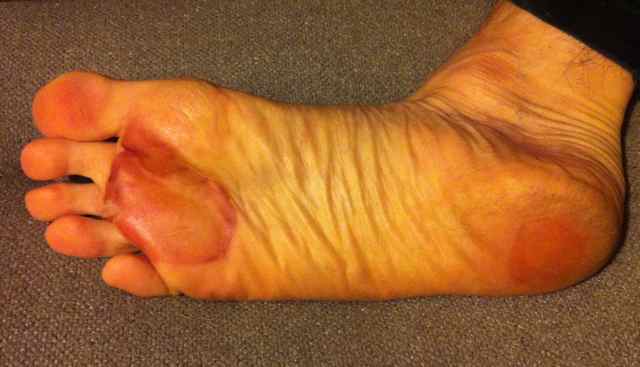 (right foot 4 days after the race) | Note to self: No-tears baby shampoo does not prevent tears in adults. The C&O Canal 100 Miler is my third attempt at that distance — and like the previous two such (2010-05-15 - Half Massanutten Mountain Trails and 2012-04-07 - Philly 100 Endurance Run) it ends with a DNF (Did Not Finish) a little past the halfway point. This time the killer factors are feet. Besides big fluid-filled pillows, my soles turn into hamburger, bruised so that I'm walking like Grandpa McCoy (as played by Walter Brennan) in the 1950s sitcom "The Real McCoys". Almost more painful, at mile 45 when that thought bubbles up, the theme song of that show gets stuck in my head for the remainder of the race. Arggghhhh! The next day I puncture the big sac at the front of the left foot and release ~5 cc of fluid. The corresponding cushion on the right foot has spontaneously broken and flattened out. Underneath the calluses there are other blisters, less evident. The bruises are worst on the right heel; the left heel seems mostly ok. |
| Note to self: When you get a rock or sand in a shoe, take it out sooner rather than later. As the proverb goes, beware of races where the Sun is going to lap you. On Monday morning, two days after the DNF, I'm walking like a 75-year-old with arthritis. That's much much better than on Sunday when I was more like a 95-year-old. I do a net-present-value calculation in my head to decide whether it's worth taking the last ice cube, since that would require a walk between refrigerator and sink to refill the tray and then a walk back. Why did my feet betray me? Perhaps I should have trained on surfaces comparable to that of the towpath, and at a walking pace that matched what I maintained during the race. Perhaps gaiters and thicker socks would have made a difference. But enough kvetching! The C&O Canal 100 is a fine event, well-organized and with super-helpful volunteers at all the aid stations. Overall it's enjoyable, a huge learning experience. Maybe next time I'll get a bit farther? DS Merle kindly rises at 4am and drives me out to Camp Manidokan near Harpers Ferry. We stop on the way at the Knoxville/Brunswick mini-mart (a Sheetz) for munchies. Nineteen hours later Merle picks me up, arriving with perfect timing within 3 minutes of my arrival at the halfway point. Thanks, Son! Timeline of the day's events as told by my tweets along the way: 4:19am: heading up to C&O Canal 100 miler start - tnx to DS Merle for driving me! 6:59am: Race begins! 10:21am: C&O Canal mile 12.5 avg 16 min/mi - trekking DFL with comrade Marshall - great conversation! 12:41pm: passing Brunswick - mile 21 - at 16 min/mi 3:14pm: Nolands ferry - mile 31 - at 16 min/mi - swallowtail butterflies 6:08pm: Brunswick - mile 42 - at 16 min/mi 7:18pm: Keep Tryst aid station - mile 45.5 - feet not good - will see if I can make it to halfway point - sorry, fans! | 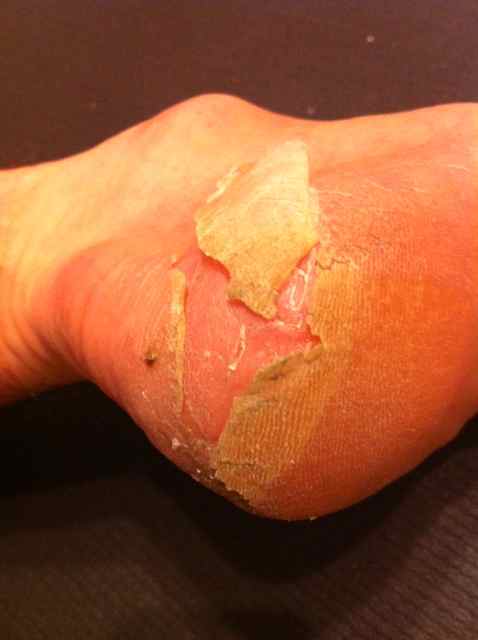 (heel of right foot two weeks after the race) |
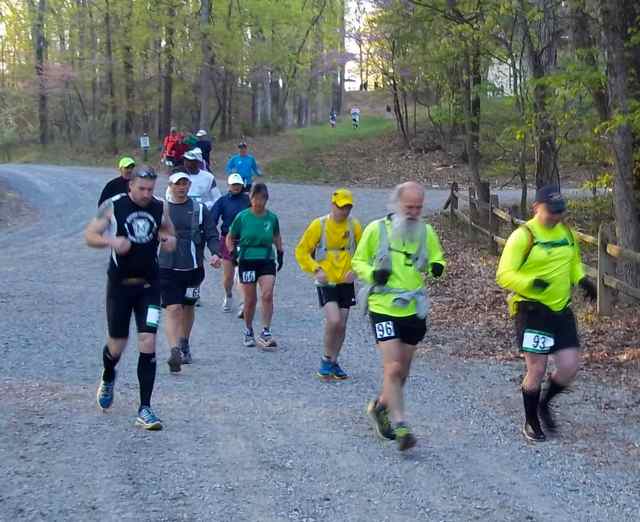 (photo by Bill Susa near the start — the last point that both of my feet leave the ground) | Note to self: Thank goodness for grab bars in shower post-race. At the end, during the final steep climb back to Camp Manidokan, huge kudos to volunteer Bill Susa. He pretends to be doing something else as he cheerfully follows me up the hillside and makes sure I get safely back to the Start/Finish area. His kind company is quite welcome at that point. Along the way, I spend most of the race in the company of D. Marshall Porterfield, Purdue University professor currently working as a senior NASA program administrator. Marshall is also an Ironman, an ultrarunner who has completed several 100 milers, a gentleman, and a scholar. Our conversations include discussions of:
- intermittent fasting, which (like Stephanie Fonda) Marshall practices
- general nutrition and dietary supplement issues
- space exploration, physics and bioengineering experiments
- ultrarunning experiences Marshall has enjoyed, along with lessons-learned
- Ironman training suggestions (and answers to my naïve questions)
- optimal race strategy at varied distances and the value of negative splits
- fly fishing
- dealing with arthritis and other health issues
- proper pacing, esp. the importance of not starting out too fast One memorable Porterfield quote: "Ultrarunners are Ultrapeople" — meaning they're ultra-NICE people! And then there's Marshall's First Rule of Feet: "If they're hurting, don't look at them!" Before the race we chat. Marshall has forgotten to bring a watch, so I lend him mine. He suffers from knee problems during and after the 2013-04-13 - Bull Run Run 2013 a fortnight ago, where dear friend Stephanie Fonda and I first meet him. So today Marshall cruises at a brisk ~15 min/mi walk all day. I catch up with him at mile ~1 and thereafter stick with him as much as possible. As darkness begins to fall Marshall realizes that he has left his headlamp and flashlight at his Camp Manidokan drop bag. I offer to lend him one of mine, but instead at the Keep Tryst aid station, mile ~45, he sensibly decides to call it a day before the sun sets. I sit next to him and ponder the options as I eat some vegan soup with noodles that helpful volunteers have given us. Then I foolishly try to continue onward alone. |
| Note to self: When running on gravel, wear gaiters (Comrade Caren Jew gave me some lovely ones many years ago. On race day, they're forgotten at home.) Perhaps the Final Rule of Ultra Club should be: "You do NOT talk about Intestinal Incidents!" — but sometimes rules must be bent, especially if there are lessons to be learned from what happened to me about mile 33. Fortunately I carry several paper towels, and there are no other runners or hikers nearby. A welcome portajohn appears within the next mile and after a brief wait I get my turn. Thankfully, it's well-stocked with toilet paper. The next aid station offers wet-wipes, a few of which I take with me into a nearby latrine. They sting the bum and do the trick. All day along the towpath I meet hikers with bibs that say "ODH", with subscripts "50k" or "100k". After much fruitless speculation I finally ask, and learn that ODH means One Day Hike, a Sierra-Club-sponsored activity. The 50k people start at Whites Ferry, the 100k in DC at the Georgetown mile 0 origin of the C&O Canal towpath. All of them proceed into Harpers Ferry and a couple of miles up the hill there to finish. They're uniformly cheerful, encouraging, and amazed to hear that I'm attempting to do 100 miles. Between miles 35 and 37 an inspirational comment comes to mind: "... the Quit Switch was officially flipped to the off position ...", from Travis Wildeboer's 2013 Barkley Marathons finisher report. Alas, my Quit Switch slips back to "maybe" by mile 40, and then goes to "on" during the final half-dozen miles. That hike in the night is noteworthy for peepers, tree-frogs that shout at me as I pass by. Earlier in the day big turtles sun themselves on sticks in the Canal. During the event I exchange text messages and quick phone calls with Kate Abbott, Mike Edwards, and Mary Ewell. They kindly volunteer to come pace me through the night, but I tell them not to and thank them profusely. All get über-credit for friendship and willingness to help! Stephanie Fonda also texts to keep track of me; she is volunteering at the Keep Tryst Aid Station overnight. Sadly, I get there before she arrives and don't have a chance to see her. (cf. Keep Tryst for Stephanie's observations and 100 Mile Eyes for her poem) My attempts to be mindful and not identify with the pain in my feet — observe it, don't cling to it — are partially successful and probably explain how I managed to complete the final half-dozen miles of my DNF. In the dark I discover that walking in a straight line readjusts fluids in the blisters so that the pain is quite tolerable. But whenever I step on a small rock or turn a slight corner, things get ugly again. | 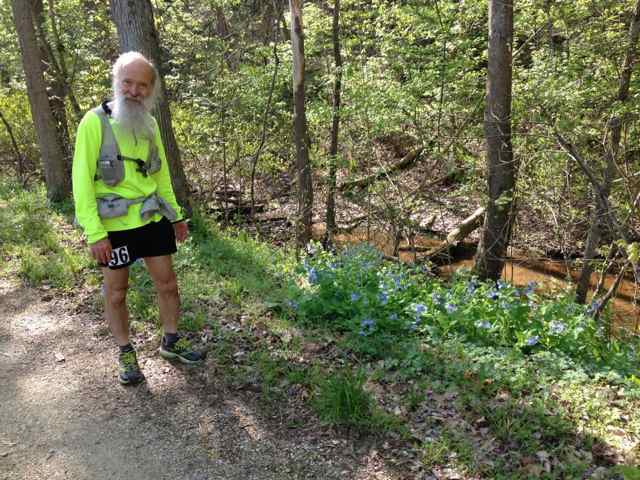 ("Just bury me here, under these bluebells!" I request — photo by D. Marshall Porterfield) |
The Garmin GPS and Runkeeper track files generally agree; Runkeeper is missing ~20 minutes of data near the ~10 mile point when I inadvertently pause data recording.
- Tuesday, May 21, 2013 at 05:01:33 (EDT)
In December 2012 American writer Silas House posted a quietly thoughtful essay, "The Art of Being Still" in the New York Times "Draft" blog. It's about the need for a writer (or anyone else!) to pay attention, deliberately, nonjudgmentally, in the present moment — what House calls "being still". He observes:
... I am being still even in my most active moments. This is because I'm not talking about the kind of stillness that involves locking yourself in a room with a laptop, while you wait for the words to come. We writers must learn how to become still in our heads, to achieve the sort of stillness that allows our senses to become heightened. The wonderful nonfiction writer Joyce Dyer refers to this as seeing like an animal.
Most writers today have jobs or families or responsibilities, and most often, all three. We don't have time to sit in the woods for a few hours every day, staring at the leaves, pondering life's mysteries and miracles and the ways we can articulate them for the reading masses.
We writers must become multitaskers who can be still in our heads while also driving safely to work, while waiting to be called "next" at the D.M.V., while riding the subway or doing the grocery shopping or walking the dogs or cooking supper or mowing our lawns.
We are a people who are forever moving, who do not have enough hours in the day, but while we are trying our best to be parents and partners, employees and caregivers, we must also remain writers.
There is no way to learn how to do this except by simply doing it. We must use every moment we can to think about the piece of writing at hand, to see the world through the point of view of our characters, to learn everything we can that serves the writing. We must notice details around us, while also blocking diversions and keeping our thought processes focused on our current poem, essay or book.
This way of being must be something that we have to turn off instead of actively turn on. It must be the way we live our lives. ...
Precisely — being mindful. Translate "writer" to "human being". Every word applies to everyone who wants to be aware and alive.
When asked at a reading how long he writes every day, House reports that he once was inspired to reply, "I write every waking minute." He observes, notes, mentally records. He's there. Perhaps it's like what the protagonist was doing in the film "Shakespeare in Love", capturing bits of dialogue from overhead conversations in daily life. Or what David Foster Wallace described in his commencement address "This Is Water".
House concludes with advice he got from the late author James Still: "Discover something new every day."
(and is the title and key-word theme of House's essay a sly play on James Still's name? hmmmmm!)
- Monday, May 20, 2013 at 06:53:28 (EDT)
In Chapter 4 ("Spontaneity") of Impro for Storytellers Keith Johnstone quotes from Maximum Performance by Laurence Moorhouse and Leonard Goss about how athletes feel after a superb result:
... I don't remember any particular moment during the event. It all seemed so easy. At the finish, the way the crowd was cheering told me I had done well, but I had the feeling that if I had only tried a little harder I could have done much better.
Johnstone continues, "And yet it's obvious that forgetting to try harder gave them their success."
(cf. NotCare (2006-02-13), ...)
- Sunday, May 19, 2013 at 12:43:39 (EDT)

Decorative masonry on four houses, all built in 1939 on Linden Lane in Silver Spring, MD, USA ...
- Saturday, May 18, 2013 at 15:28:40 (EDT)
A sweet yet subtle suggestion in Chapter 33 ("Enjoy Your Hands") of Just One Thing by Rick Hanson: appreciate your body, and especially your hands, "... unique in the animal kingdom in their dexterity and sensitivity. Their capacity for skilled action helped drive the evolution of the neural networks that handle sophisticated planning, decision-making, and self-control."
So, Hanson proposes, be aware of your hands in all their glorious activities. Sounds simple? It's not. But it does bring to mind the final verse of a lovely Paul Simon song, "Duncan":
Oh, oh, what a night
Oh, what a garden of delight
Even now that sweet memory lingers
I was playing my guitar
Lying underneath the stars
Just thanking the Lord
For my fingers
For my fingers |
- Friday, May 17, 2013 at 14:15:53 (EDT)
During a brown-bag seminar today, one participant began a sentence with the ultimate introductory phrase:
"Ethical issues aside, ..."
With that as a prefix, you know something wild is about to be said!
- Thursday, May 16, 2013 at 19:14:42 (EDT)
~10.5 miles @ ~11.9 min/mi
4 cyclists + 3 other runners + 2 clusters of noisy kids + 1 scampering rabbit = a fun run in the dark from McLean to Silver Spring. Sara Crum has invited comrades to her lovely home for a potluck dinner and conversation about the upcoming Bighorn trail race in Wyoming that several of them plan to participate in. Jennifer Weiland, Jennifer Sample, Ken Swab, and Barry Smith bring spouses and friends and kids. I hitch a ride with Barry in order to practice eating following by running in the nighttime. After too much feasting I thank our hosts and slip out a little after 9pm.
The jog out of Sara's neighborhood is brief, and from then onward I'm more-or-less repeating two prior runs, 2007-05-25 - Home Run Meltdown and 2010-03-12 - Homeward Bound. This time, though, it's dark and the journey is spookier. The shoulder of VA-123 (Dolley Madison Hwy) feels narrow, so I try to run on the grass when cars zoom past. At the GW Memorial Parkway I cross and take the natural-surface Potomac Heritage Trail through the woods.
A rabbit scampers away from my flashlight beam, as startled by me as I am by it. Careful treading, to avoid a game-ending stumble on rock or root, now slows the pace. Heavy rains yesterday make Pimmit Run rather high, so at mile 2 I get soggy socks crossing when some of the stepping stones are submerged. A nighttime fisherman greets me at the Virginia end of Chain Bridge. After crossing the Potomac into DC I hesitate, then during a gap between cars dart across the Clara Barton Parkway and scramble up the steep path to join the Capital Crescent Trail near milepost 7.
"On your left," a cyclist without lights warns me as he zips by. Tired now, I start taking a ~1 minute walk break every ~5 minutes. Half a dozen noisy young men are walking near the trail at the River Rd bridge. Another small crew hangs out at the eastern end of the tunnel under Wisconsin Av in Bethesda. My pace improves as I home nears. Runkeeper roughly agrees with Garmin GPS splits of 10:51 + 17:34 + 15:48 + 10:41 + 11:21 + 11:12 + 10:46 + 10:14 + 10:53 + 10:52 and a final fractional dash at 10:21 min/mi.
At 11:14pm when I arrive at the front steps, who is sitting there but DS Merle?! He forgot his house key, so after a friend drops him off he walks a couple of miles to Wheaton Plaza, buys a towel to wrap around himself against the cold, and walks back. He hasn't been waiting too long, he says. As I let him in who should pull up in the car but DW Paulette & DD Gray? They return from the Metro which they took downtown to a concert at the Library of Congress. DS Robin is still away, playing Dungeons & Dragons in the College Park area.
- Wednesday, May 15, 2013 at 06:59:56 (EDT)
"But I could be wrong!" That's how I end many of my rambling disquisitions and mini-lectures. Recently I ran across the perfect philosophical label for that: "Fallibilism", the notion that people should never feel too certain about their beliefs.
And just the other evening, chatting with DS Robin, I suddenly realized that whenever I call myself a Fallibilist it's crucial to add the disclaimer, "But I could be wrong!"
(cf. My Affectations, ...)
- Tuesday, May 14, 2013 at 07:05:44 (EDT)
~10 miles @ ~10.8 min/mi
"Eeew!" A flat snake decorates Beach Drive at mile 4.5 of our trek. This morning after a tardy start from home I'm last to arrive at the Candy Cane City parking lot, in the brown loaner MINI Cooper while the black one is in the shop. Rebecca Rosenberg is just ahead of me, and Jennifer Weiland and Ken Swab are already waiting. We trot down Rock Creek Trail and then Beach Dr to tag the barrier gate at Broad Branch Rd. Ken channels various other friends in doing crudely funny commentary. Rebecca recommends the movie The Mighty Macs. As we approach the DC line on our return journey, Sara Crum suddenly appears running toward us; she had a late start due to scheduled-then-canceled athletic events for her kids. Runkeeper concurs roughly with Garmin GPS splits of 11:18 + 10:25 + 9:58 + 12:26 + 9:49 + 10:41 + 10:40 + 10:48 + 11:46 + 10:18.
- Monday, May 13, 2013 at 07:00:32 (EDT)
Reflections on oneness, in Chapter 9 ("Breaking the Skin Born of Mother") of No Beginning, No End by Jakusho Kwong:
... Your intention to help others is the main cause of your own salvation. People suffer because they are always thinking of themselves and remain caught in their own problems. Dharma practice means forgetting your problems through helping others. ...
and a bit later:
... mirroring each other is one of the most intimate things we have to offer. If you're sad, I feel sad. If you're happy, I feel very happy. If you're clear, I feel clear. If you're dull, I feel dull. This is the process of seeing things as it is, which is a phrase Suzuki-roshi often used. Because we're able to see things as it is, we are not attached to them. Things do come and go. Usually people grasp what they see and hold on to it. Through true practice we become less opinionated and less judgmental. Even though we have opinions, they're not so self-centered, and we see with the eye of compassion.
Nonjudgment plus oneness: 0 + 1. The chapter ends by explaining (if it can be explained!) what its title means:
The sentence "It means sitting and breaking the skin born of mother" may sound extraordinary. It tells us that through our zazen we come to realize we are not just this object, this child who came from our mother. To break the skin born of mother is to break your karma, your bondage, your delusion. It means that you break through this person born of your mother. Sometimes it is called being unborn. This is real knowing.
(cf. Indra's Net, ...)
- Sunday, May 12, 2013 at 07:28:04 (EDT)
For back issues of the ^zhurnal see Volumes
v.01 (April-May 1999),
v.02 (May-July 1999),
v.03 (July-September 1999),
v.04 (September-November 1999),
v.05 (November 1999 - January 2000),
v.06 (January-March 2000),
v.07 (March-May 2000),
v.08 (May-June 2000),
v.09 (June-July 2000),
v.10 (August-October 2000),
v.11 (October-December 2000),
v.12 (December 2000 - February 2001),
v.13 (February-April 2001),
v.14 (April-June 2001),
0.15 (June-August 2001),
0.16 (August-September 2001),
0.17 (September-November 2001),
0.18 (November-December 2001),
0.19 (December 2001 - February 2002),
0.20 (February-April 2002),
0.21 (April-May 2002),
0.22 (May-July 2002),
0.23 (July-September 2002),
0.24 (September-October 2002),
0.25 (October-November 2002),
0.26 (November 2002 - January 2003),
0.27 (January-February 2003),
0.28 (February-April 2003),
0.29 (April-June 2003),
0.30 (June-July 2003),
0.31 (July-September 2003),
0.32 (September-October 2003),
0.33 (October-November 2003),
0.34 (November 2003 - January 2004),
0.35 (January-February 2004),
0.36 (February-March 2004),
0.37 (March-April 2004),
0.38 (April-June 2004),
0.39 (June-July 2004),
0.40 (July-August 2004),
0.41 (August-September 2004),
0.42 (September-November 2004),
0.43 (November-December 2004),
0.44 (December 2004 - February 2005),
0.45 (February-March 2005),
0.46 (March-May 2005),
0.47 (May-June 2005),
0.48 (June-August 2005),
0.49 (August-September 2005),
0.50 (September-November 2005),
0.51 (November 2005 - January 2006),
0.52 (January-February 2006),
0.53 (February-April 2006),
0.54 (April-June 2006),
0.55 (June-July 2006),
0.56 (July-September 2006),
0.57 (September-November 2006),
0.58 (November-December 2006),
0.59 (December 2006 - February 2007),
0.60 (February-May 2007),
0.61 (April-May 2007),
0.62 (May-July 2007),
0.63 (July-September 2007),
0.64 (September-November 2007),
0.65 (November 2007 - January 2008),
0.66 (January-March 2008),
0.67 (March-April 2008),
0.68 (April-June 2008),
0.69 (July-August 2008),
0.70 (August-September 2008),
0.71 (September-October 2008),
0.72 (October-November 2008),
0.73 (November 2008 - January 2009),
0.74 (January-February 2009),
0.75 (February-April 2009),
0.76 (April-June 2009),
0.77 (June-August 2009),
0.78 (August-September 2009),
0.79 (September-November 2009),
0.80 (November-December 2009),
0.81 (December 2009 - February 2010),
0.82 (February-April 2010),
0.83 (April-May 2010),
0.84 (May-July 2010),
0.85 (July-September 2010),
0.86 (September-October 2010),
0.87 (October-December 2010),
0.88 (December 2010 - February 2011),
0.89 (February-April 2011),
0.90 (April-June 2011),
0.91 (June-August 2011),
0.92 (August-October 2011),
0.93 (October-December 2011),
0.94 (December 2011-January 2012),
0.95 (January-March 2012),
0.96 (March-April 2012),
0.97 (April-June 2012),
0.98 (June-September 2012),
0.99 (September-November 2012),
0.9901 (November-December 2012),
0.9902 (December 2012-February 2013),
0.9903 (February-March 2013),
0.9904 (March-May 2013),
0.9905 (May-July 2013),
0.9906 (July-September 2013),
0.9907 (September-October 2013),
0.9908 (October-December 2013),
0.9909 (December 2013-February 2014),
0.9910 (February-May 2014),
0.9911 (May-July 2014),
0.9912 (July-August 2014),
...
Current Volume.
Send comments and suggestions to z (at) his.com. Thank you! (Copyright © 1999-2014 by Mark Zimmermann.)





